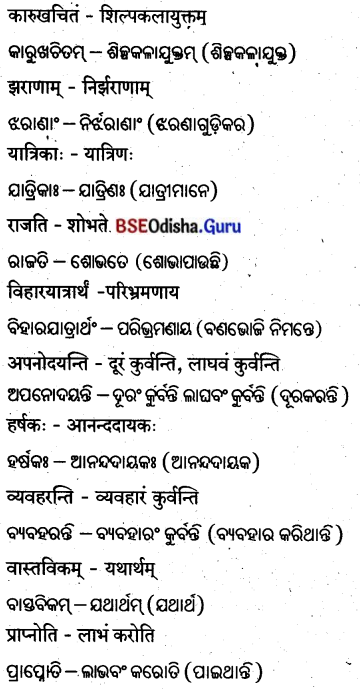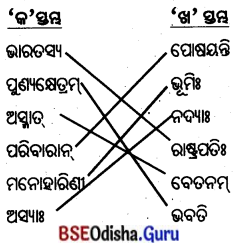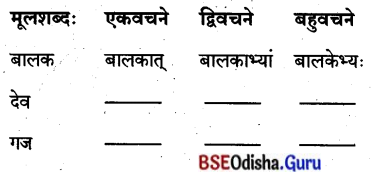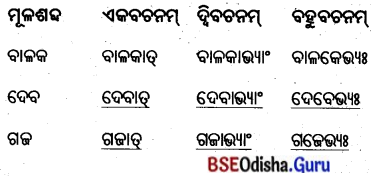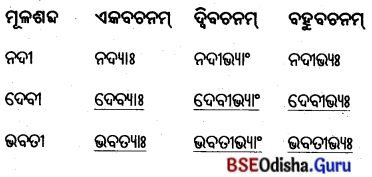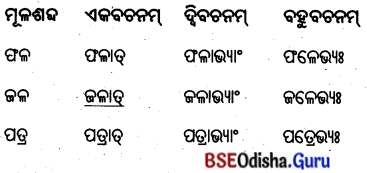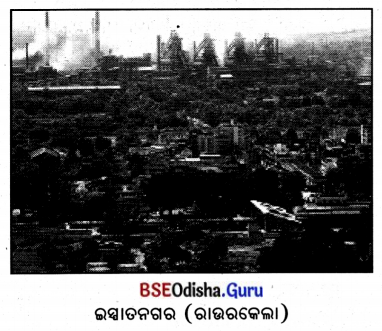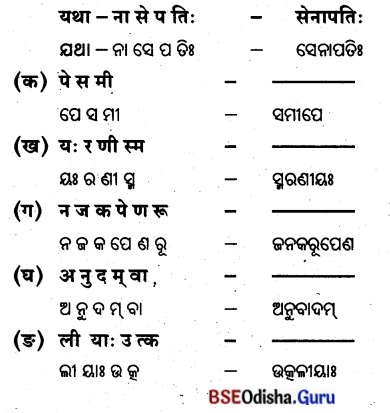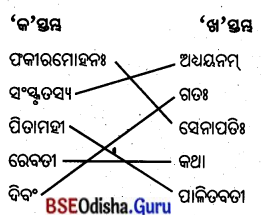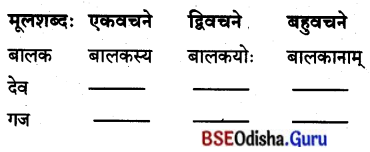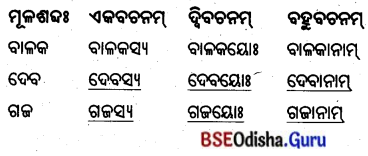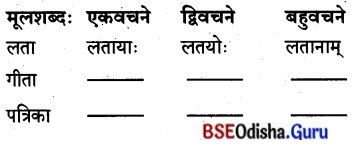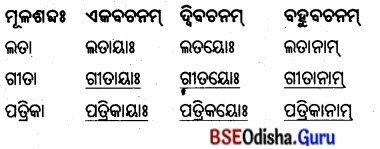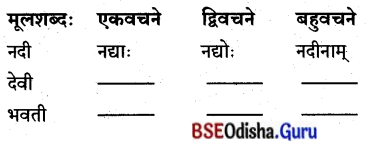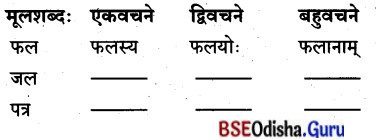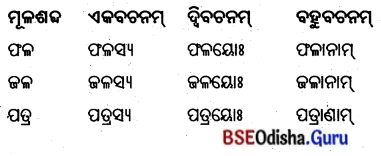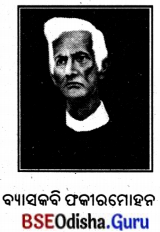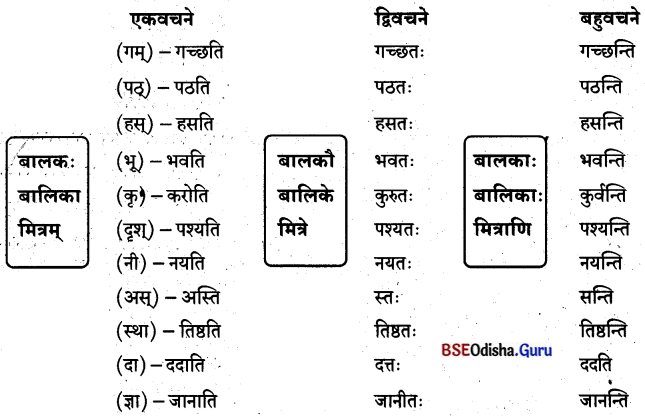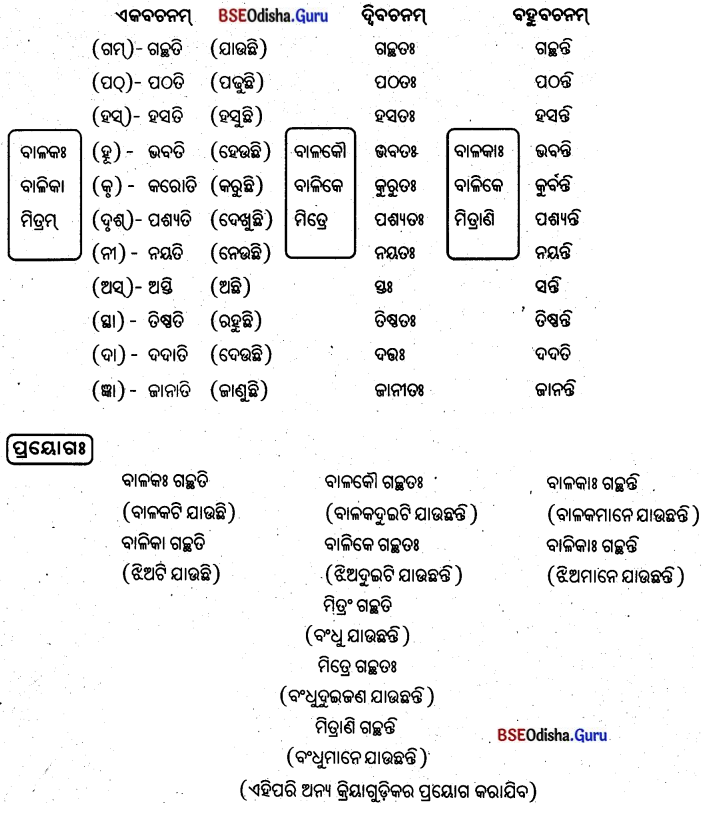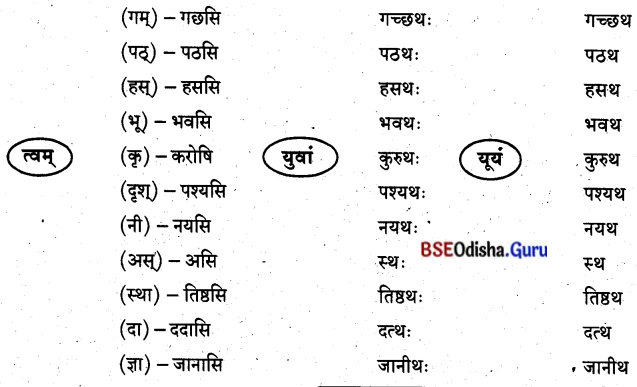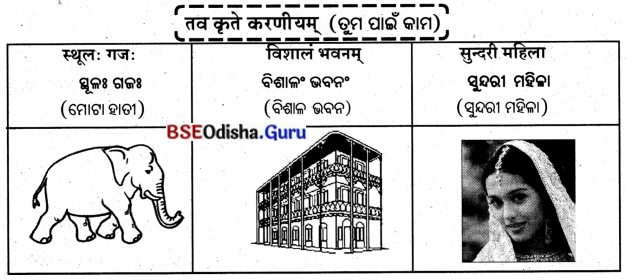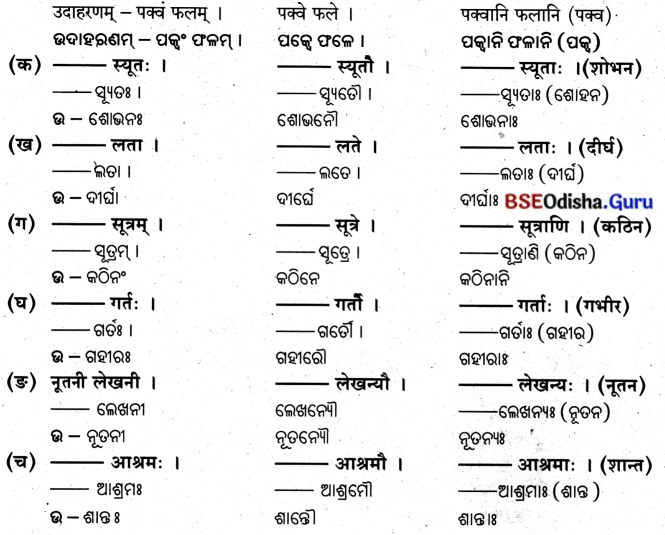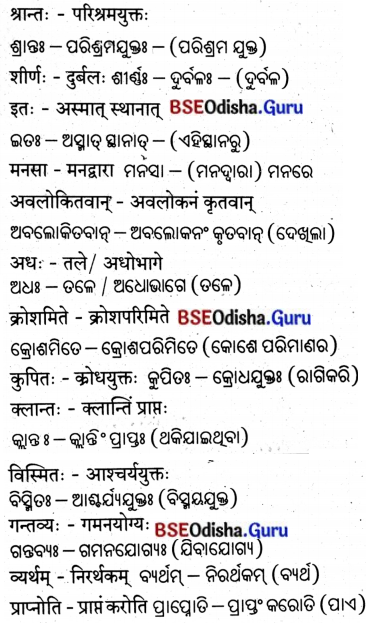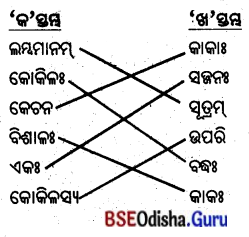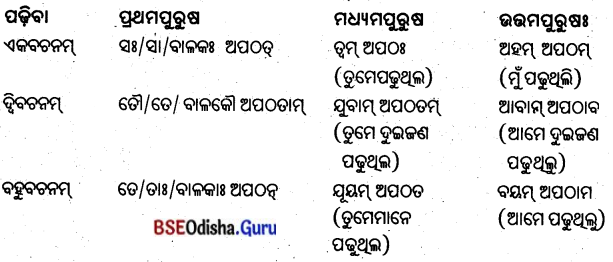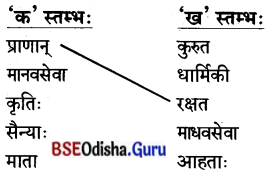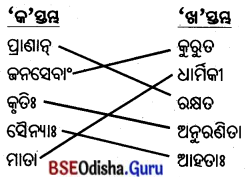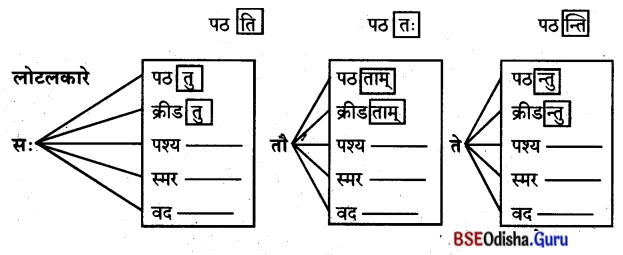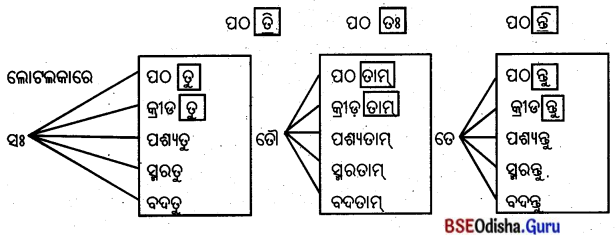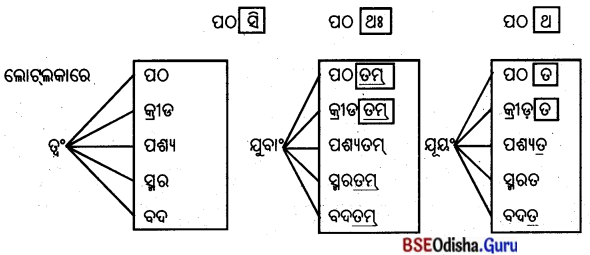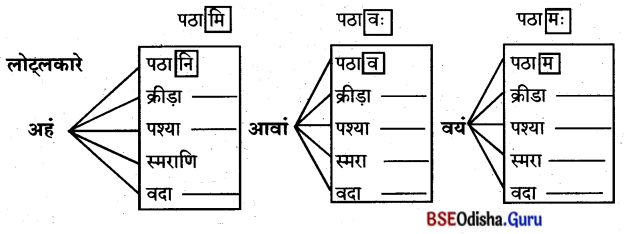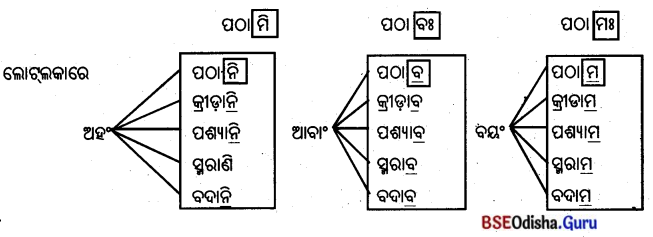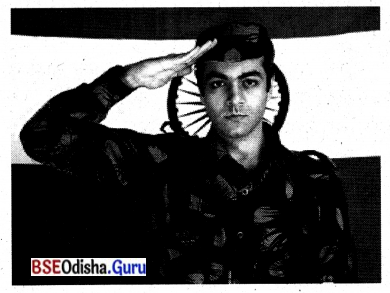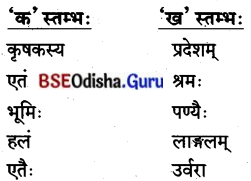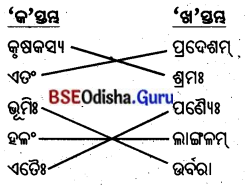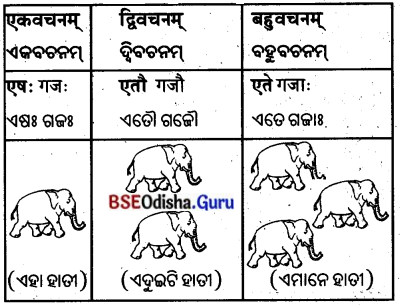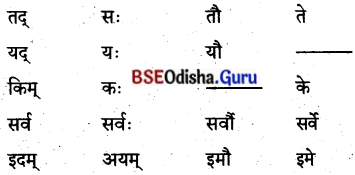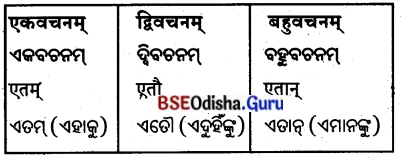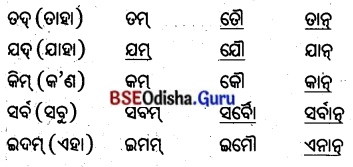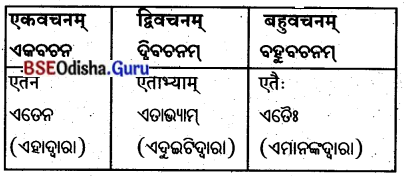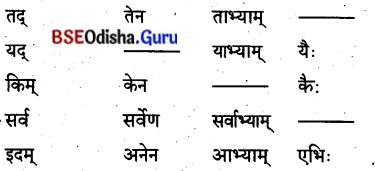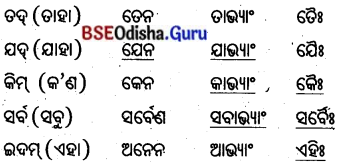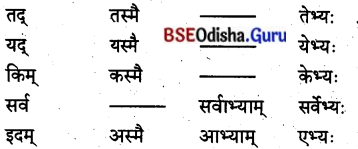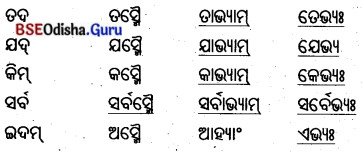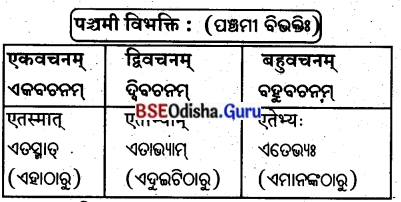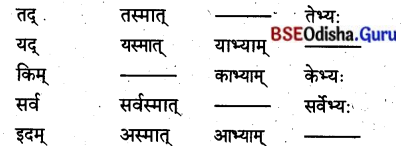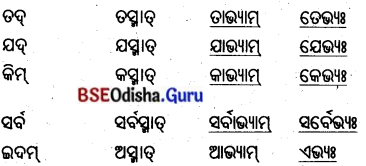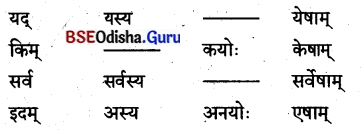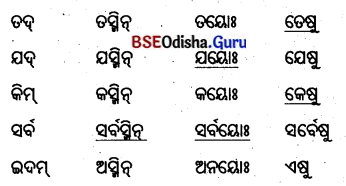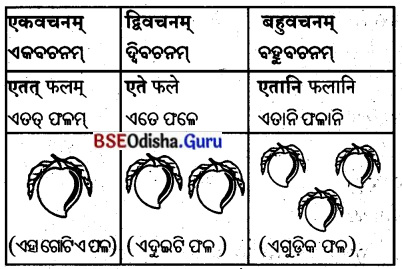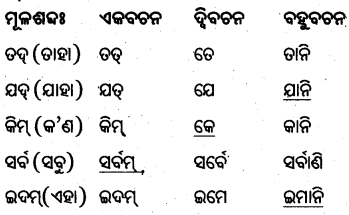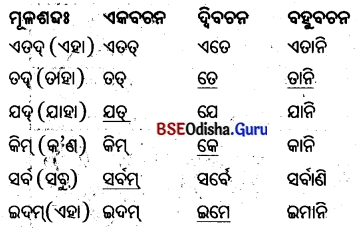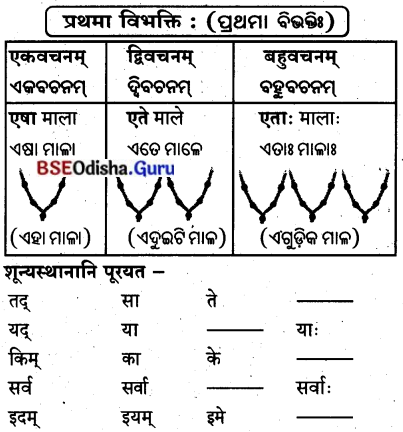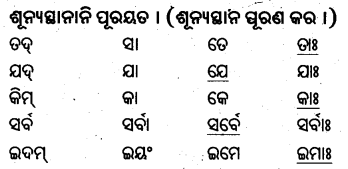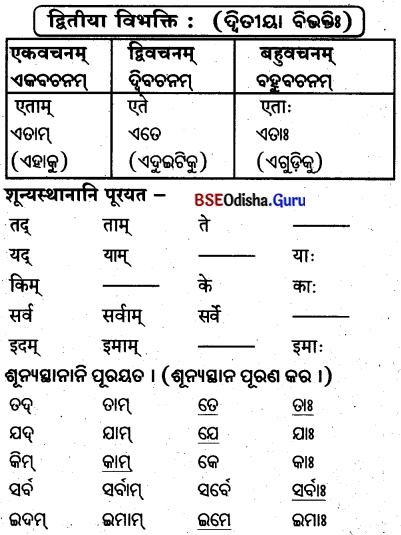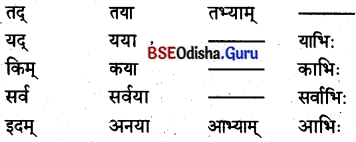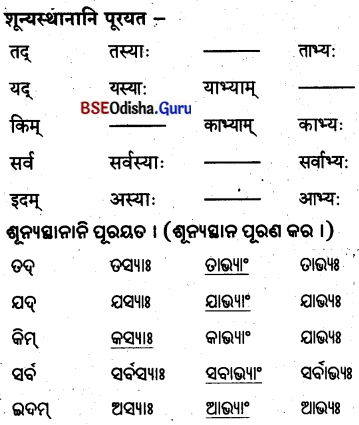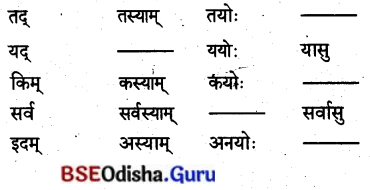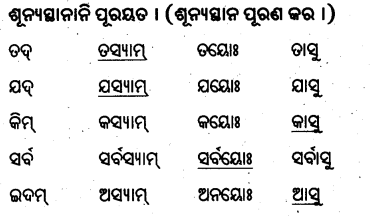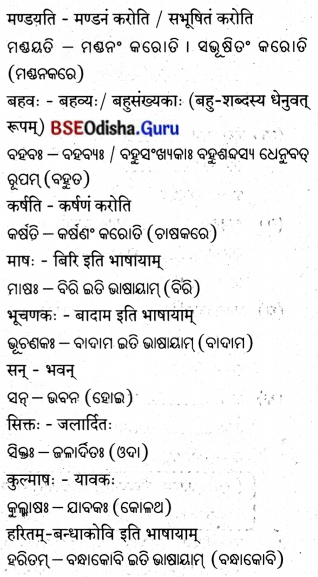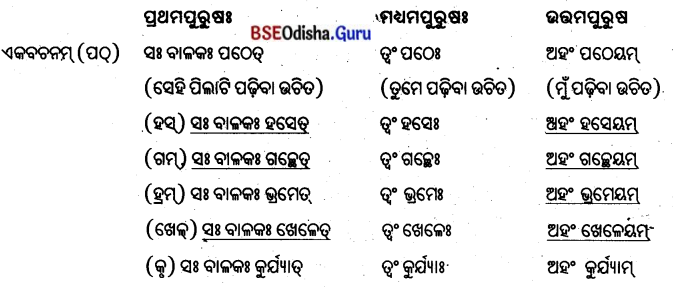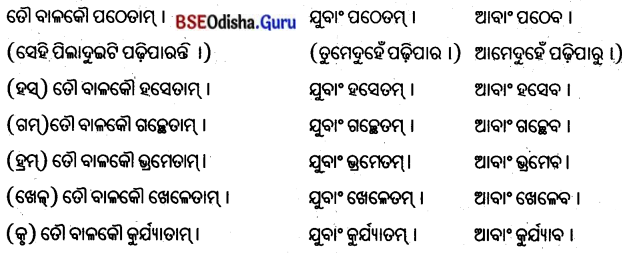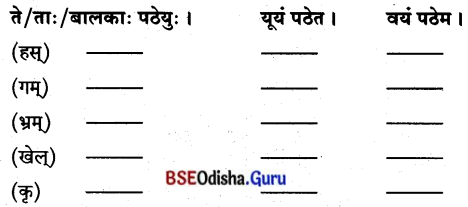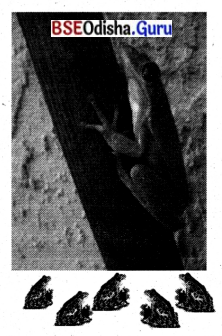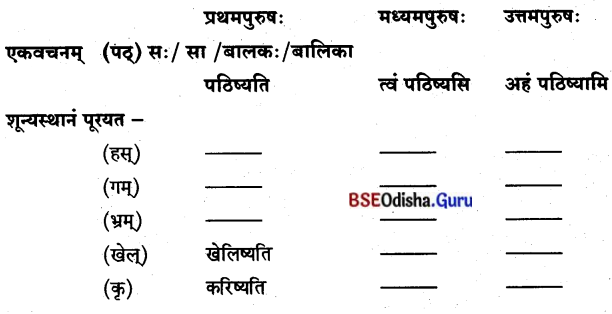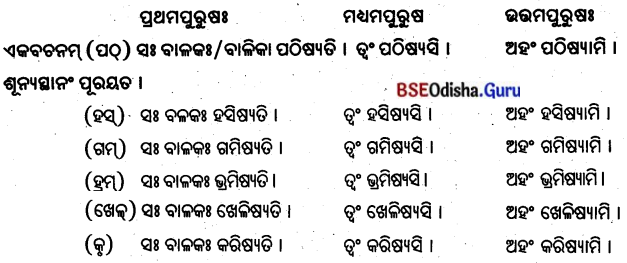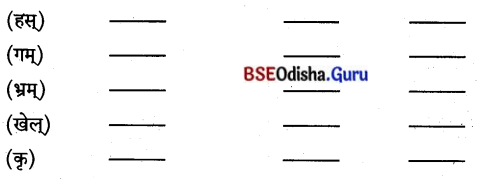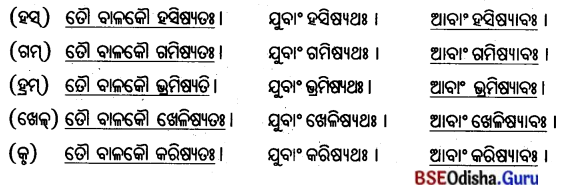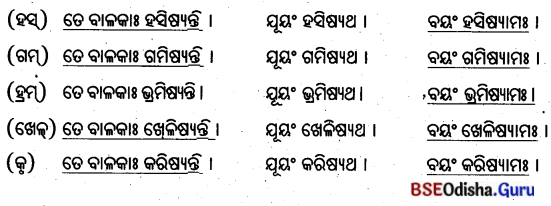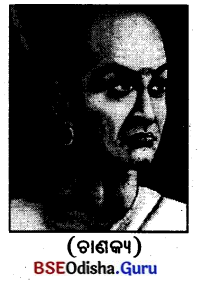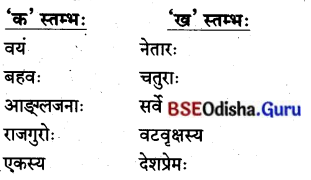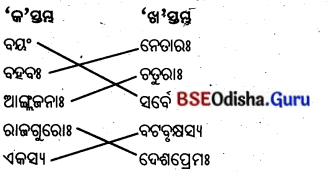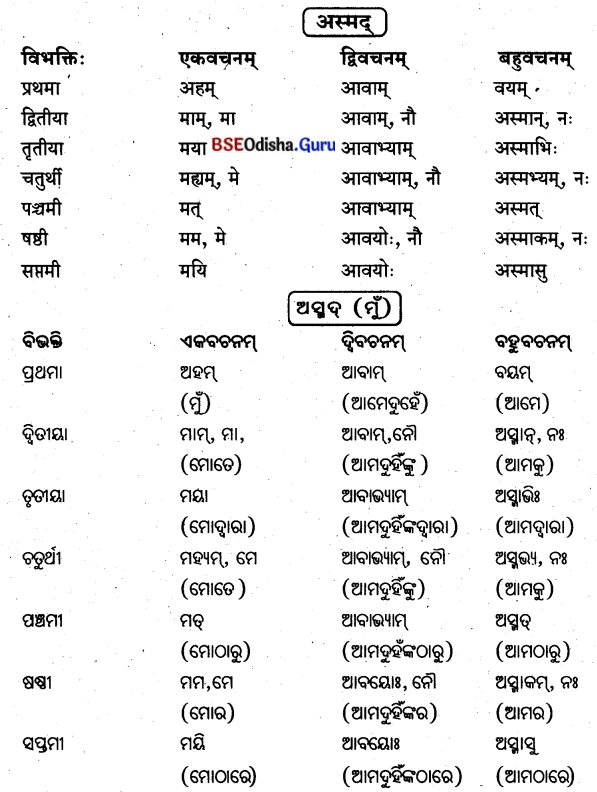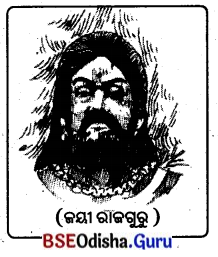Odisha State Board BSE Odisha 8th Class Sanskrit Solutions Chapter 6 ଗନ୍ଧମାଦନଃ Textbook Exercise Questions and Answers.
BSE Odisha Class 8 Sanskrit Solutions Chapter 6 ଗନ୍ଧମାଦନଃ
1. एकपदेन उत्तरं कुरुत । (ଏକପଦେନ ଉତ୍ତରଂ କୁରୁତ ।)
(ଗୋଟିଏ ପଦରେ ଉତ୍ତର ଦିଅ ।)
(क) गन्धमादने परिमलगिरिः इति कः लिखितवान् ?
ଗନ୍ଧମାଦନଂ ପରିମଳଗିରି ଇତି ଡଃ ଲିଖୁତବାନ୍ ?
उत्तर:
ହେନସାଙ୍ଗ
![]()
(ख) भक्ताः देवाय किम् अर्पयन्ति ?
ଭକ୍ତା ଦେବାୟ କିମ୍ ଅର୍ପୟନ୍ତ ।
उत्तर:
ପୁଷ୍ପାଘାଂ
(ग) के मन्दिरस्य शोभां वर्द्धयन्ति ?
କେ ମନ୍ଦିରସ୍ୟ ଶୋଭାଂ ବର୍ଷୟନ୍ତି ।
उत्तर:
ପୁଷ୍ପପାଦପା
(घ) पर्यटका: विहारयात्रार्थं कुत्र आगच्छन्ति ?
ପର୍ଯ୍ୟଟକା ବିହାରଯାତ୍ରାମିଂ କୁତ୍ର ଆଗଛନ୍ତି ।
उत्तर:
ହରିଶଙ୍କରମ୍
(ङ) का हरिशंकरमन्दिरं निर्मितवती ?
କା ହରିଶଙ୍କରମନ୍ଦିରଂ ନିର୍ମିତବତୀ ।
उत्तर:
ଦୁର୍ଲଭାଦେବୀ
(पुष्पार्घ्यम्, ह्नेनसाङ्र :, पुष्पपादपा:, दुर्लभादेवी, हरिशुरूरम्)
(ପୁଷ୍ପାର୍ଘ୍ୟମ, ହେନସାଙ୍ଗ, ପୁଷ୍ପପାଦପା, ଦୁର୍ଲଭାଦେବୀ, ହରିଶଙ୍କରମ୍ )
2. बन्धनीमध्यस्थयथार्थशब्दैः शून्यस्थानानि पूरयत
(ବନ୍ଧନୀ ମଧ୍ଯସ୍ଥଯଥାର୍ଥଶଜୈ ଶୂନ୍ୟସ୍ଥାନାନି ପୂରୟତ ।)
(ବନ୍ଧନୀ ମଧ୍ଯରେ ଥିବା ଯଥାର୍ଥ ଶବ୍ଦରେ ଶୂନ୍ୟସ୍ଥାନ ପୂରଣ କର ।)
(क) अत्र नानाविधाः पशुपक्षिणः ……………
(निवसति, निवसतः, निवसन्ति)
ଅତ୍ର ନାନାବିଧା ପଶୁପକ୍ଷିତଃ ……………
(ନବସତି, ନିବସତଃ, ନିବସର୍ଚ)
उत्तर:
ନିବସନ୍ତି
![]()
(ख) ………….. उभयतः प्राकृतिकशोभा रमणीया ।
(मार्गस्य, मार्गम्, मार्गाय)
………….. ଉଭୟତଃ ପ୍ରାକୃତିକଶୋଭା ରମଣୀୟା ।
(ମାର୍ଗସ୍ୟ, ମାର୍ଗମ୍, ମାର୍ଗୀୟ )
उत्तर:
ମାର୍ଗମ୍
(ग) दृश्यम् अतीव …………….. भवति ।
(मनोहर:, मनोहारी, मनोहरम्)
ଦୃଶ୍ୟମ୍ ଅତୀବ …………… ଭବତି ।
(ମନୋହରଃ, ମନୋହରୀ, ମନୋହରମ୍)
उत्तर:
ମନୋହରଂ
(घ) ………….. पुष्पार्घ्यं समर्पयन्ति ।
(तस्मात्, तस्मिन्, तस्मै)
…………… ପୁଷ୍ପାର୍ଘ୍ୟ ସମର୍ପୟର୍ଡ । (ତସ୍ମାତ୍, ତସ୍ମିନ୍, ତନ୍ମେ)
उत्तर:
ତନ୍ମେ
(ङ) देवं प्रणमन्ति ।
(भक्तौ, भक्त्या, भक्तः)
………….. ଦେବଂ ପ୍ରଣମନ୍ତ । (ଭକ୍ଷ୍ନୌ, ଭକ୍ତା, ଭଦୁଃ)
उत्तर:
ଭକ୍ତା
3. मातृभाषया अनुवादं कुरुत :
(ମାତୃଭାଷୟା ଅନୁବାଦଂ କୁରୁତ ।) (ମାତୃଭାଷାରେ ଅନୁବାଦ କର ।)
(क) अत्र नानाविधाः पशुषक्षिणः निवसन्ति
ଅତ୍ର ନାନାବିଧା ପଶୁପକ୍ଷିତଃ ନିବସର୍ତ୍ତ ।
उत्तर:
ଏଠାରେ ବିବିଧ ପ୍ରକାର ପଶୁପକ୍ଷୀ ବାସକରନ୍ତି ।
(ख) यात्रिका: भक्ताः परिवारेण सह आगच्छन्ति ।
ଯାତ୍ରିକାଂ ଭକ୍ତା ପରିବାରେଣ ସବୁ ଆଗଛନ୍ତି ।
उत्तर:
ଯାତ୍ରୀମାନେ ଭକ୍ତମାନେ ପରିବାର ସହିତ ଆସନ୍ତି ।
(ग) तस्मै पुष्पार्घ्यं समर्पयन्ति |
ତନ୍ମେ ପୁୱାସ୍ଥ୍ୟ ସମର୍ପୟର୍ଶ ।
उत्तर:
ତାଙ୍କୁ ପୁଷ୍ପାର୍ଘ୍ୟ ସମର୍ପଣ କରନ୍ତି ।
(घ) शीतकाले अत्रत्यपरिवेशः हर्षकः ।
ଶୀତକାଳେ ଅତ୍ରତ୍ୟପରି ବେଶଃ ବର୍ଷକଃ ।
उत्तर:
ଶୀତସମୟରେ ଏଠାରେ ଥିବା ପରିବେଶ ଆନନ୍ଦପ୍ରଦ ।
![]()
(ङ) अतः एतत् स्थानं सर्वेषां दर्शनीयम् ।
ଅତଃ ଏତତ୍ ସ୍ଥାନଂ ସର୍ବେଶାଂ ଦର୍ଶନୀୟମ୍ ।
उत्तर:
ଏଣୁ ଏହି ସ୍ଥାନଟି ସମସ୍ତଙ୍କର ଦର୍ଶନ ଯୋଗ୍ୟ ।
4. शुद्धपदं लिखत । (ଶୁଦ୍ଧପଦଂ ଲିଖତ ।)
(ଶୁଦ୍ଧ ପଦ ଲେଖ।)
- ग मा न्ध द न: ଗ ମା ନ୍ଧ ଦ ନଃ – ଗନ୍ଧମାଦନଃ
- पु ष्प पा पाः द ପୁଷ୍ପ ପା ପା ଦ – ପୁଷ୍ପପାଦପା ଶଂ
- शं रि ह क रः ଶଂ ରି ହ କ ରଃ – ହରିଶଙ୍କରଃ
- ग: ह्वे सां न ଶଃ ହ୍ନେ ସାଂ ନ – ସ୍ପେନସାଂଗ
- ना नृ ह सिं थः ନା ନୃ ହ ସିଂ ଥା – ନୃସିଂହନାହଃ
5. स्तम्भमेलनं कु रुत ସ୍ତମ୍ଭମେଳ ନଂ କୁରୁ ତ
(ସ୍ତମ୍ଭମେଳନ କର ।)
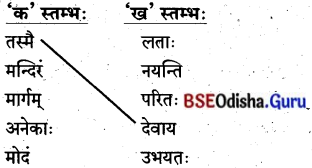
उत्तर:

6. रेखाङ्क्रितपदस्य संशोधनं कुरुत। (ରେଖାଙ୍କିତପଦସ୍ୟ ସଂଶୋଧନଂ କୁରୁତ।)
(ରେଖାଙ୍କିତ ପଦର ସଂଶୋଧନ କର ।)
(क) पर्वतस्य त्रिकषा महाविद्यालयः अस्ति ।
(ପର୍ବତସ୍ୟ ନିକଷା ମହାବିଦ୍ୟାଳୟ ଅଛି ।)
उत्तर:
ପର୍ବତଂ ନିକଷା ମହାବିଦ୍ୟାଳୟ ଅସ୍ତ ।
(ख) ते भक्तिना देवं पूजयन्ति ।
(ତେ ଭକ୍ତନା ଦେବଂ ପୂଜସ୍ପର୍ଶ ।)
उत्तर:
ଜ ତେ ଭକ୍ତ ଦେବଂ ପୂଜୟନ୍ତି ।
(ग) नानाविधाः पशुपक्षयः निवसन्ति ।
(ନାନାବିଧା ପଶୁପକ୍ଷୟଃ ନିବସର୍ଗ ।)
उत्तर:
ନାନାବିଧା ପଶୁପକ୍ଷିଣ ନିବସନ୍ତି ।
(घ) झराणां कलनादः चित्ताकर्षकम् ।
(ଝରଣା କଳନାଦଃ ଚିତ୍ତାକର୍ଷକମ୍ ।)
उत्तर:
ଝରାନାଂ କଳନାଦଃ ଚିତ୍ତାକର୍ଷକଃ ।
![]()
(ङ) शीतकाले अन्त्यपरिवेशः हर्षकाः।
(ଶୀତକାଳେ ଅତ୍ରତ୍ୟପରିବେଶଃ ବର୍ଷକା ।)
उत्तर:
ଶୀତକାଳେ ଅତ୍ରତ୍ୟପରିବେଶଃ ହର୍ଷକଃ ।
7. वाक्यानि रचयतं । (ବାକ୍ୟ ରଚନା କର ।)
(ବାକ୍ୟାନି ରଚୟତ।)
निकषा, उभयतः, परितः, विना
उत्तर:
- निकषा (ନିକଷା) – ଶିକ୍ଷକଂ ନିକଷା ଉପବିଶ।
- उभयतः (ଉଭୟତଃ) – ମାର୍ଗମ୍ ଉଭୟତଃ ବୃକ୍ଷା ଶୋଭନ୍ତେ ।
- परितः (ପରିତଃ) – ବିଦ୍ୟାଳୟଂ ପରିତଃ ପ୍ରାଚୀରମ ଅସ୍ତି ।
- विना (ବିନା) – ଜଳ ବିନା ଜୀବନଂ ନାସ୍ତି ।
8. सन्धिविच्छेदं कुरुत। (ସନ୍ଧିବିଚ୍ଛେଦ କର ।)
(ସନ୍ଧିବିଚ୍ଛେଦଂ କୁରୁତ।)
चित्ताकर्षकः, पुष्पार्घ्यम्, पर्वतारोहणस्य, विहारयात्रार्थम्, कश्चित् ।
उत्तर:
- चित्ताकर्षकः (ଚିତ୍ତାକର୍ଷକ) = ଚିତ୍ତ + ଆକର୍ଷକ
- पुष्पार्घ्यम् (ପୁଷ୍ପାର୍ଜ୍ୟମ୍) = ପୁଷ୍ପ + ଅର୍ଘ୍ୟମ୍
- पर्वतारोहणस्य (ପର୍ବତାରୋହଣସ୍ୟ) = ପର୍ବତ + ଆରୋହଣସ୍ୟ
- विहारयात्रार्थम् (ବିହାରଯାତ୍ରାର୍ଥମ୍) = ବିହାରଯାତ୍ରା + ଅର୍ଥମ୍
- कश्चित् । (କଶ୍ଚିତ) = କଃ + ଚିତ୍
- अतीव (ଅତୀବ) = ଅତି + ଇବ
तव कृते करणीयम् (ତୁମ ପାଇଁ କାମ)
(क) उच्चै: पठत, लिखत च – (अकारान्त .पुंलिङ़शब्दा:)
(କ) ଉଚ୍ଚୈଃ ପଠତ (ବଡ଼ପାଟିରେ ପଢ଼) ଲିଖିତ ଚ ଲେଖ)
(ଏବଂ ଅକାରାନ୍ତ ପୁଂଲିଙ୍ଗଶବ୍ଦା (ଅକାରାନ୍ତ ପୁଂଲିଙ୍ଗଶବ୍ଦ)
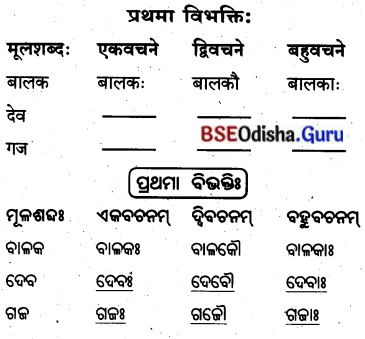
(आकारान्त – स्रीलिङ्ग-शब्दा:)
ଆକାରାନ୍ତ – ସ୍ତ୍ରୀଲିଙ୍ଗ-ଶବ୍ଦ (ଆକାରାନ୍ତ ସ୍ତ୍ରୀଲିଙ୍ଗ ଶବ୍ଦ)
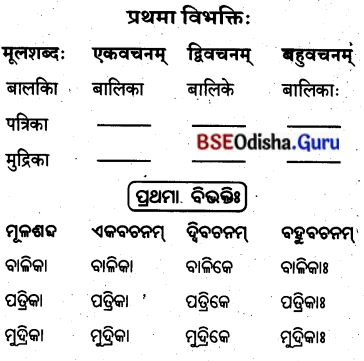
(ईकारान्त – स्रीलिङ्र-शब्दा:)
ଈକାରାନ୍ତ -ସ୍ତ୍ରୀଲିଙ୍ଗ-ଶବ୍ଦା
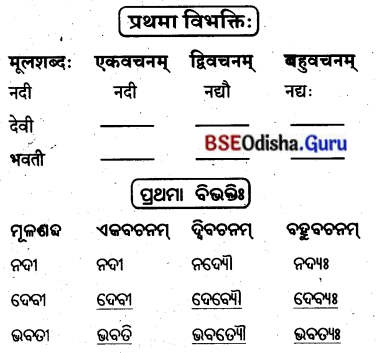
![]()
(अकारान्त – नपुंसकलिङ्ग-शब्दा:)
ଅକାରାନ୍ତ ନପୁଂସକଲିଙ୍ଗଶବ୍ଦା
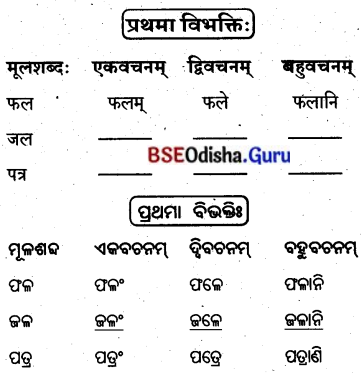
(ख) उच्चै: पठत, लिखत च – (अकारान्त – पुंलिङ्गशब्दा:)
ଉଚ୍ଚୈଃ ପଠତ ଲିଖତ ଚ । ଅକାରାନ୍ତ ପୁଂଲିଙ୍ଗଶବ୍ଦା (ଅକାରାନ୍ତ ପୁଂଲିଙ୍ଗଶବ୍ଦ)
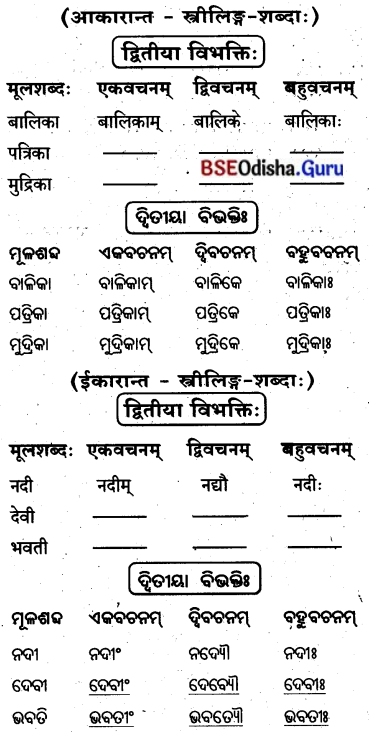

(ग) उच्चै: पठत, लिखत च – (अकारान्त – पुंलिङ्नशब्दाः)
ଉଚ୍ଚୈଃ ପଠତ ଲିଖତ ଚ । ଅକାରାନ୍ତ ପୁଂଲିଙ୍ଗଶବ୍ଦା (ଅକାରାନ୍ତ ପୁଂଲିଙ୍ଗଶବ୍ଦ)
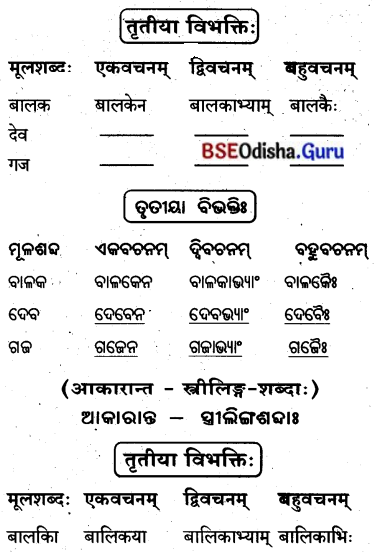
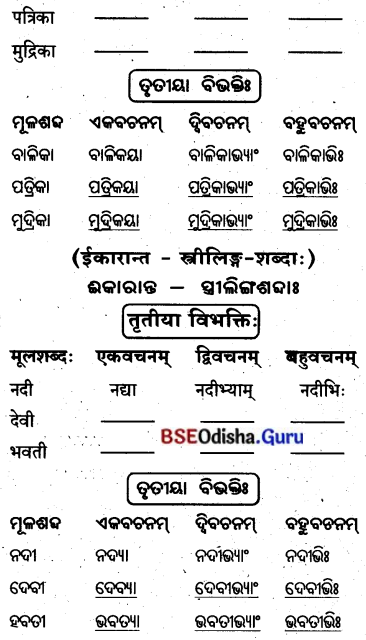
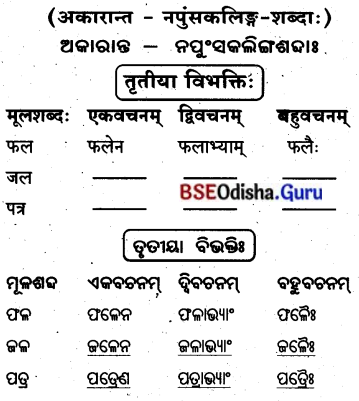
![]()
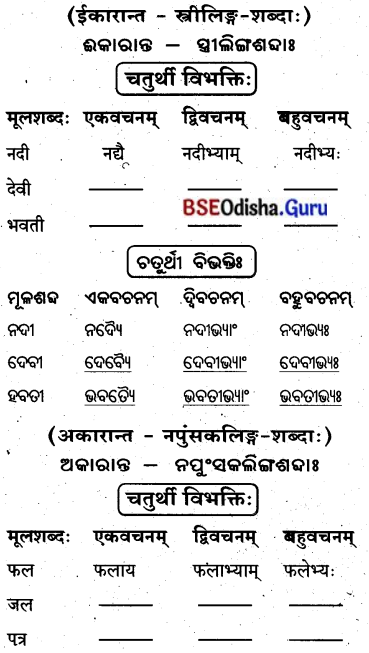
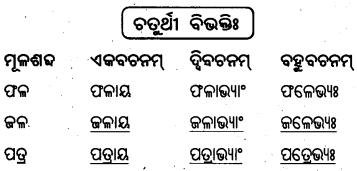
एकपदेन उत्तरं लिखत ।
(ଏକପଦେନ ଉତ୍ତରଂ ଲଖତ ।)
प्रश्न 1.
दुर्ल्लभादेवी कस्य पत्नी ?
ଦୁର୍ଲ୍ଲଭାଦେବୀ କସ୍ୟ ପନ୍ଥୀ ?
उत्तर:
ବୈଜଳଦେବସ୍ୟ
प्रश्न 2.
कुतः सप्तविंशति क्रोशदूरे गन्धमादनः अस्ति ?
କୃତଃ ସପ୍ତବିଂଶତି କ୍ରୋଶଦୂରେ ଗନ୍ଧମାଦନଃ ଅସ୍ଥି ?
उत्तर:
ବଲାଙ୍ଗିରତଃ
प्रश्न 3.
पुष्पपादपः कस्य शोभां बर्द्धयन्ति ?
ପୁଷ୍ପପାଦପଃ କସ୍ୟ ଶୋଭାଂ ବର୍ଷୟନ୍ତି ?
उत्तर:
ମନ୍ଦିରସ୍ଯ
प्रश्न 4.
के देवाय पुष्पार्घ्यम् अर्पयन्ति ?
କେ ଦେବାୟ ପୁଷ୍ପାର୍ଘ୍ୟମ୍ ଅର୍ପୟନ୍ତି ?
उत्तर:
ଭକ୍ତା
प्रश्न 5.
गन्धमादनः कस्मिन् मण्डले अस्ति ?
ଗନ୍ଧମାଦନଃ କସ୍ମିନ୍ ମଣ୍ଡଳେ ଅଛି ?
उत्तर:
ବଲାଙ୍ଗିରମଣ୍ଡଳେ
![]()
प्रश्न 6.
के विहारयात्रार्थं हरिशड्करमन्दिरम् आगच्छन्ति ?
କେ ବିହାରଯାତ୍ରାମିଂ ହରିଶଙ୍କରମନ୍ଦିରମ୍ ଆଗଛନ୍ତି ?
उत्तर:
ପର୍ଯ୍ୟଟକା
प्रश्न 7.
पर्ययटकाः किमर्थ हरिशंकरंम् आगच्छत्ति ?
ପର୍ଯ୍ୟଟକା କିମର୍ଥ୍ୟ ହରିଶଙ୍କରଂ ଆଗଛନ୍ତି ?
उत्तर:
ବିହାରଯାତ୍ରାର୍ଥମ୍
प्रश्न 8.
दुर्लभादेवी किं निर्मितवती ?
ଦୁର୍ଲଭାଦେବୀ କିଂ ନିର୍ମିତବତୀ ?
उत्तर:
ହରିଶଙ୍କରମନ୍ଦିରମ୍
प्रश्न 9.
विलासीजना:हयिश:क्षरं केन रूपेण व्यवहरन्ति?
ବିଳାସୀଜନାଃ ହରିଶଙ୍କରଂ କେନ ରୂପେଣ ବ୍ୟବହରନ୍ତି ?
उत्तर:
ଗ୍ରୀଷ୍ମନିବାସରୂପେଣ
वन्धनीम़ध्यात् शून्यस्थानं पूररयत।
1. वृद्धः …………….. गच्छति ।
କୃଷକଃ …………… ଗଚ୍ଛତି । (ଦଣ୍ଡେ, ଦଣ୍ଡେନ, ଦଣ୍ଡାୟ)
उत्तर:
ଦଣ୍ଡେନ
2. कृषक: ……………… खनति । (खनित्रेण, खनित्राय, खनित्रे)
କୃଷକଃ………………. ଖନତି । (ଖନିତ୍ରେଣ, ଖନିତ୍ରାୟ, ଖନିତ୍ରେ)
उत्तर:
ଖନିତ୍ରେଣ
3. भवन्त: ………….. सह मा श्रमनु । (दुष्टभि:, दुहै:, दुष्टेस्य:)
ଭବତଃ …………….. ସହ ମା ଭ୍ରମନ୍ତୁ । (ଦୁଷ୍ଟାନିଃ, ଦୁର୍ଷେ, ଦୁଷ୍ଟଭ୍ୟ)
उत्तर:
ଦୁଷ୍ଟି
4. यूयं ………… सह कन्दुकेन क्रीड़त । (अस्मिन्,अस्माभिः,अस्माकं)
ସହ ………………… କନ୍ଦୁକେନ କ୍ରୀଡ଼ତ । (ଅସ୍ମିନ୍, ଅସ୍ମାଭିଂ, ଅସ୍ମାକଂ)
उत्तर:
ଅସ୍ମାଭି
5. बालक:………… विना मूर्खाः भवन्ति । (अध्ययनं,अध्यनाय,अध्ययने)
ବାଳକା …………………ବିନା ମୂର୍ଖା ଭବନ୍ତି।
उत्तर:
ଅଧ୍ୟୟନଂ
6. जननी ………… खाद्यं यच्छति । (पुत्राय,पुत्रं,पुत्रे)
ଜନନୀ ……. ଖାଦ୍ୟ ଯଚ୍ଛତି । (ପୁତ୍ରାୟ, ପୁତ୍ର, ପୁତ୍ରେ)
उत्तर:
ପୁତ୍ରାୟ
![]()
7. छात्रा: ………… अर्च्चयन्ति । (गणेशाय,गणेशम्,गणेशम्)
ଛାତ୍ରା ………… ଅର୍ଜୟନ୍ତି । (ଗଣେଶାୟ, ଗଣେଶମ୍, ଗଣେଶମ୍)
उत्तर:
ଗଣେଶମ୍
8. ……………. परितः छात्रा: तिष्ठिन्ति । (शिक्षकस्य, शिक्षकं, शिक्षकाय)
……………. ପରିତଃ ଛାତ୍ରା ତିଷ୍ଠନ୍ତି | (ଶିକ୍ଷକସ୍ୟ, ଶିକ୍ଷକଂ, ଶିକ୍ଷାକାୟ)
उत्तर:
vଶିକ୍ଷକଂ
9. मम ……….. प्रयोजनम् अस्ति । (धने, धनेन, धनायं)
ମମ …………… ପ୍ରୟୋଜନମ୍ ଅସ୍ଥି । (ଧନେ, ଧନେନ, ଧନାୟ)
उत्तर:
ଧନେନ
10. मुनयः ……….. अधिवसन्ति । (आश्रमम्, आश्रमे, आश्र्रमस्य)
ମୁନୟଃ,……………….. ଅଧୂବସନ୍ତି । (ଆଶ୍ରମମ୍, ଆଶ୍ରମେ, ଆଶ୍ରମସ୍ୟ)
उत्तर:
ଆଶ୍ରମମ୍
11. अत्र नानाविधा: पशुपक्षिण: (निवसति, निवसत:, निवसन्ति)
ଅତ୍ର ନାନାବିଧା ପଶୁପକ୍ଷିଣ __
उत्तर: ନିବସନ୍ତି :
उत्तरचयनं कुरुत । (ନିବସତି, ନିବସତଃ, ନିବସନ୍ତି)
(ଉତ୍ତରଚୟନଂ କୁରୁତ।)
प्रश्न 1.
का हरिशुर्क्रमन्दिरं निर्मितवती?
(A) ଦୁର୍ଲ୍ଲଭାଦେବୀ
(B) ସରଳାଦେବୀ
(C) ମମତାଦେବୀ
(D) ଭୁବନେଶ୍ଵରୀଦେବୀ
उत्तर:
(A) ଦୁର୍ଲ୍ଲଭାଦେବୀ
प्रश्न 2.
बलाड़िरतः कियत् द्वरे गन्थमादनः अस्ति?
ବଲାଙ୍ଗିରତଃ କିୟତ୍ ଦୂରେ ଗନ୍ଧମାଦନଃ ଅସ୍ଥି ?
(A) ପଞ୍ଚବିଂଶତି କ୍ରୋଶ
(B) ଚତୁଃବିଂଶତି କ୍ରୋଶ
(C) ସପ୍ତବିଂଶତି କ୍ରୋଶ
(D) ଅଷ୍ଟବିଂଶତି କ୍ରୋଶ
उत्तर:
(C) ସପ୍ତବିଂଶତି କ୍ରୋଶ
प्रश्न 3.
पर्य्यटका :बिहारयात्रार्थं कुत्र आगछन्ति ?
ପର୍ଯ୍ୟଟକା ବିହାରଯାତ୍ରାମିଂ କୃତ୍ର ଆଗଛନ୍ତି ?
(A) ଗନ୍ଧମାଦନମ୍
(B) ହରିଶଙ୍କରମ୍
(C) ବାଲେଶ୍ଵରମ୍
(D) ବଲାଙ୍ଗିରମ୍
उत्तर:
(B) ହରିଶଙ୍କରମ୍
![]()
प्रश्न 4.
के मन्दिरस्य शोभां वर्द्धयन्ति?
କେ ମନ୍ଦିରସ୍ୟ ଶୋଭାଂ ବର୍ଷୟନ୍ତି ?
(A) ପାଦପା
(B) ବୃକ୍ଷ
(C) ପୁଷ୍ପପାଦପା
(D) ବୃହତ୍ପାଦପା
उत्तर:
(C) ପୁଷ୍ପପାଦପା
प्रश्न 5.
भक्ता:देवाय किम् अर्पयन्ति ?
ଭକ୍ତା ଦେବାୟ କିମ୍ ଅର୍ପୟନ୍ତି ?
(A) ପୁଷ୍ପମ୍
(B) ଅର୍ଘ୍ୟମ୍
(C) ଧୂପମ୍
(D) ପୁଷ୍ପାର୍ଜ୍ୟମ୍
उत्तर:
(D) ପୁଷ୍ପାର୍ଜ୍ୟମ୍
प्रश्न 6.
गन्थमादनः कुत्र अस्ति ?
ଗନ୍ଧମାଦନଃ କୁତ୍ର ଅସ୍ତି ?
(A) ବଲାଙ୍ଗିରମଣ୍ଡଳେ
(B) ମଣ୍ଡଳେ
(C) ବାଲେଶ୍ଵରେ
(D) ମେଦିନୀପୁରେ
उत्तर:
(A) ବଲାଙ୍ଗିରମଣ୍ଡଳେ
प्रश्न 7.
के देवाय पुष्पार्घ्यम् अर्पयन्ति ?
କେ ଦେବାୟ ପୁଷ୍ପାର୍ଘ୍ୟମ୍ ଅର୍ପୟନ୍ତ ?
(A) ଦେବାଃ
(B) ଭକ୍ତା
(C) ଜନାଃ
(D) ଆସ୍ତିକା
उत्तर:
(B) ଭକ୍ତା
प्रश्न 8.
पुष्पपादपाः कस्य शोभां वर्द्धयन्ति ?
ପୁଷ୍ପପାଦପା କସ୍ୟ ଶୋଭାଂ ବର୍ଷୟନ୍ତି ?
(A) ଗୃହସ୍ଯ
(B) ବିଦ୍ୟାଳୟସ୍ୟ
(C) ମନ୍ଦିରସ୍ଯ
(D) ମାର୍ଗସ୍ୟ
उत्तर:
(C) ମନ୍ଦିରସ୍ଯ
प्रश्न 9.
क:गन्धमादनं परिमलगिरि:इति लिखितवान् ?
କଃ ଗନ୍ଧମାଦନଂ ପରିମଳଗିରି ଇତି ଲିଖୁତବାନ୍ ?
(A) ଦୁର୍ଲ୍ଲଭାଦେବୀ
(B) ବିଶ୍ଵନାତଃ
(C) ମୁକୁନ୍ଦଦେବ
(D) ହେନସାଂଗ
उत्तर:
(D) ହେନସାଂଗ
प्रश्न 10.
अत्र पर्वतशिक्षरात् जलप्रपातः किं करोति ?
ଅତ୍ର ପର୍ବତଶିଖରାତ୍ ଜଳପ୍ରପାତଃ କିଂ କରୋତି ?
(A) ତୁଷାରଭ୍ରମମ୍
(B) ଭ୍ରମମ୍
(C) ମନୋରମମ୍ ତୁଷାରଭ୍ରମମ୍
(D) ରମଣୀୟମ୍
उत्तर:
(A) ତୁଷାରଭ୍ରମମ୍
रेखांकित पदानां संशोधनं कुरुत।
(ରେଖାଙ୍କିତପଦାନାଂ ସଂଶୋଧନଂ କୁରୁତ।)
1. झरणां कलनादः चित्ताकर्षम् ।
ଝରାଣା କଳନାଦଃ ଚିତ୍ତାକର୍ଷମ୍ ।
उत्तर:
ଝରାନାଂ କଳନାଦଃ ଚିତ୍ତାକର୍ଷକ ।
2. पर्वतस्य निकषा महाविद्यालयः अस्ति।
ପର୍ବତସ୍ୟ ନିକଷା ମହାବିଦ୍ୟାଳୟ ଅସ୍ଥି ।
उत्तर:
ପର୍ବତଂ ନିକଷା ମହାବିଦ୍ୟାଳୟ ଅସ୍ତି।
![]()
3. शीतकाले अन्तर्यपरिवेशः हर्षका।
ଶୀତକାଳେ ଅତ୍ରତ୍ୟପରିବେଶଃ ହର୍ଷକା ।
उत्तर:
ଶୀତକାଳେ ଅତ୍ରତ୍ୟପରିବେଶଃ ହର୍ଷକଃ ।
4. नानाविधाः पशुपक्षय: निवसन्ति ।
ନାନାବିଧା ପଶୁପକ୍ଷୟ ନିବସନ୍ତି ।
उत्तर:
ନାନାବିଧା ପଶୁପକ୍ଷିଣ ‘ନିବସନ୍ତି ।
5. ते भक्तिना देवं पूजयन्ति ।
ତେ ଭଣ୍ଡିନା ଦେବଂ ପୂଜୟନ୍ତି ।
उत्तर:
ତେ ଭକ୍ତ ଦେବଂ ପୂଜୟନ୍ତି ।
6. तस्य पुष्पार्घ्यं समर्पयन्ति।
ତସ୍ୟ ପୁଷ୍ପାର୍ଘ୍ୟ ସମର୍ପୟନ୍ତି ।
उत्तर:
ତସ୍ମି ପୁଷ୍ପାଘଂ ସମର୍ପୟନ୍ତି ।
7. भक्ताः देवस्य प्रणमन्ति।
ଭକ୍ତା ଦେବସ୍ୟ ପ୍ରଣମନ୍ତି ।
उत्तर:
ଭକ୍ତା ଦେବଂ ପ୍ରଣମନ୍ତି ।
8. अत्रत्य दृश्यम् रमणीया ।
ଅତ୍ରତ୍ୟ ଦୃଶ୍ୟମ୍ ରମଣୀୟା ।
उत्तर:
ଅତ୍ରତ୍ୟ ଦୃଶ୍ଯ ରମଣୀୟମ୍ ।
9. छात्रः क्रमेण गच्छन्ति ।
ଛାତ୍ରୀ କ୍ରମେଣ ଗଛନ୍ତି ।
उत्तर:
ଛାତ୍ରା କ୍ରମେଣ ଗଛନ୍ତି ।
सन्धिविच्छेदं कुरुत। (ସନ୍ଧିବିଚ୍ଛେଦଂ କୁରୁତ।)
- अतीव (ଅତୀବ) = ଅତି + ଇବ
- चित्त्मकर्षक (ଚିତ୍ତାକର୍ଷକ) = ଚିତ୍ତ + ଆକର୍ଷକ
- पर्यटका: ପର୍ଯ୍ୟଟକା = ପରି + ଅଟକା
सन्धिं कुरुत । (ସନ୍ଧି କୁରୁତ ।)
1. पर्वत + आरोहण: = पर्वतोराहण:
ପର୍ବତ + ଆରୋହଣ = ପର୍ବତାରୋହଣ
2. यात्रा + अर्थम् = यात्रार्थम्
ଯାତ୍ରା + ଅର୍ଥମ୍ = ଯାତ୍ରାର୍ଥମ୍
क्रियापदं निर्वाचयत । (କ୍ରିୟାପଦଂ ନିର୍ବାଚୟତ।)
भवति, पुण्यभूमि:, अस्ति, हरति, ह्नेनसांगः, कलनाद: करोति, रमणीया, प्रणमन्ति, भक्ताः।
ଭବତି, ପୁଣ୍ୟଭୂମି, ଅସ୍ତି, ହରତି, ଛେନାସାଂଗ, କଳନାଦଃ କରୋତି, ରମଣୀୟା, ପ୍ରଣମନ୍ତେ, ଭକ୍ତା ।
उत्तर:
ଭବତି, ଅସ୍ତି, ହରତି, କରୋତି, ପ୍ରଣମନ୍ତ (କର୍ତ୍ତୃପଦଂ ଚିନୁତ।)
![]()
कर्त्तपद चिनुत ।
गन्धमादन:, भवति, पशुपक्षिण:, निवसन्ति, लिखितवान्, जलप्रपात:, यात्रिका:, पर्यटका:, आगच्छन्ति, व्यवहरन्ति। घर्ब्रॉपढ़ा8
ଗନ୍ଧମାଦନଃ, ଭବତି, ପଶୁପକ୍ଷିଣ, ନିବସନ୍ତି, ଲିଖତବାନ୍, ଜଳପ୍ରପାତଃ, ଯାତ୍ରିକା, ପର୍ଯ୍ୟଟକା,. ଆଗଛନ୍ତି, ବ୍ୟବହରନ୍ତି।
उत्तर:
ଗନ୍ଧମାଦନଃ, ପଶୁପକ୍ଷିଣ, ଜଳପ୍ରପାତଃ, ଯାତ୍ରିକା, ପର୍ଯ୍ୟଟକା
शब्दानां मातृभाषया अर्थान् लिखत।
(ଶବ୍ଦାନାଂ ମାତୃଭାଷୟା ଅର୍ଥାନ୍ ଲିଖତ ।)
- दर्लभा: (ଦୁର୍ଲଭା) – ଅଲବ୍ଧ
- चित्ताकर्षक: (ଚିତ୍ତାକର୍ଷକ) – ମନମୁଗ୍ଧକର
- यात्रिकाः (ଯାତ୍ରିକା) – ଯାତ୍ରିମାନେ
- राजति (ରାଜତି) – ଶୋଭାପାଏ
- परितः (ପରିତଃ) – ସ୍ଫରିପାଖରେ
- मोदम् (ମୋଦମ୍) – ଆନନ୍ଦ
- हर्षक: (ହର୍ଷିକଃ) – ଆନନ୍ଦଦାୟକ
निजभाषया प्रायशः दशभि: वाक्यै : उत्तरं लिखत
(ନିଜଭାଷୟ ପ୍ରାୟଶଃ ଦଶତିଃ ବାର୍କେ ଉତ୍ତରଂ ଲିଖତ ।)
प्रश्न 1.
गुन्धमादनविषये संक्षेपेण आलोचयत।
ଗନ୍ଧମାଦବିଷୟେ ସଂକ୍ଷେପଣ ଆଲୋଚୟତ ।
उत्तर:
ପୁଣ୍ୟଭୂମି ଉତ୍କଳ । ଯାହା ଗିରି, ନଦୀ, ବନଭୂମି ଦ୍ଵାରା ସୁଶୋଭିତ। ଏହି ପ୍ରଦେଶରେ ଅନେକ ଉଚ୍ଚ ପର୍ବତମାଳା ’ରହିଅଛି। ସେହି ଉଚ୍ଚପର୍ବତମାନଙ୍କ ମଧ୍ୟରୁ ଗନ୍ଧମାଦନ
ଅନ୍ୟତମ। ଗନ୍ଧମାଦନ ପର୍ବତମାଳାର ସମୁଚ୍ଚ ଶୃଙ୍ଗର୍ ଉଚ୍ଚତା 3234 ଫୁଟ ପରିମିତ । ଏହା ବଲାଙ୍ଗିର-ବରଗଡ଼ ମଣ୍ଡଳୟର ପ୍ରାକୃତିକ ପ୍ରାଚୀର ସଦୃଶ ସଦାସର୍ବଦା ଦଣ୍ଡାୟମାନ । ଖଣିଜଦ୍ରବ୍ୟ ନିମିତ୍ତ ଏହି ପର୍ବତ ବିଶ୍ଵ ପ୍ରସିଦ୍ଧ ଅଟେ ।
ଏହା ବଲାଙ୍ଗିରଠାରୁ27 କୋଶ ଦୂରରେ ବିରାଜମାନ। ଗନ୍ଧମାଦନ ଘନଶ୍ୟାମ୍- ବନରାଜିରେ ପରିବେଷ୍ଟିତ । ଏଣୁ ପର୍ଯ୍ୟଟକମାନଙ୍କର ମନ ହରଣ ପ କରିଥାଏ। ଏଠାରେ ନାନାପ୍ରକାର ପଶୁପକ୍ଷୀ ବାସକରନ୍ତି। ଅନେକ ଦୁର୍ଲଭ ଆୟୁର୍ବେଦ ବୃକ୍ଷଲତା ରହିଛି । ଏଣୁ ଗନ୍ଧମାଦନ ନିକଟରେ ଏକ ଆୟୁର୍ବେଦ ମହାବିଦ୍ୟାଳୟ ସ୍ଥାପିତ ହୋଇଛି । ଗନ୍ଧମାଦନର ଉତ୍ତର ପାର୍ଶ୍ଵରେ ନୃସିଂହନାଥ ମନ୍ଦିର ଓ ଦକ୍ଷିଣପାର୍ଶ୍ବରେ ହରିଶଙ୍କର ପୀଠ ଏହାର ଶୋଭାବର୍ତ୍ତନ କରାଏ । ସ୍ପେନସାଙ୍ଗ ଗନ୍ଧମାଦନ ପର୍ବତକୁ ପରିମଳଗିରି ନାମରେ ନାମିତ କରିଛନ୍ତି
प्रश्न 2.
गन्धमादनस्य शोभा कीदृशी ?
ଗନ୍ଧମାଦନସ୍ୟ ଶୋଭା କିଦୃଶୀ ?
उत्तर:
ପୁଣ୍ୟଭୂମି ଉତ୍କଳରେ ବିରାଜିତ ଉଚ୍ଚପର୍ବତମାନଙ୍କ ମଧ୍ୟରେ ଗନ୍ଧମାଦନ ଅନ୍ୟତମ। ଏହି ପର୍ବତର ଦୁଇପାର୍ଶ୍ଵରେ ଦୁଇଟି ପ୍ରସିଦ୍ଧ ପୀଠ ରହିଛି ଯାହା ଗନ୍ଧମାଦନ ପର୍ବତର ଶୋଭାବର୍ଦ୍ଧନ କରାଏ । ଉତ୍ତରପାର୍ଶ୍ବରେ ନୃସିଂହନାଥ ପୀଠ ଓ ଦକ୍ଷିଣପାର୍ଶ୍ଵରେ ହରିଶଙ୍କର ପୀଠ। .ନୃସିଂହନାଥ ମନ୍ଦିରର କାରୁକାର୍ଯ୍ୟ କୋଣାର୍କ ମନ୍ଦିର ଶୈଳୀରେ ନିର୍ମିତ। ଏଠାରେ ପର୍ବତଶିଖରକୁ ଜଳପ୍ରପାତ ତୁଷାରଭ୍ରମ କରାଏ। ଝରଣାର କଳକଳ ନାଦ ଅତ୍ୟନ୍ତ ଚିରୀକର୍ଷକ । ନୃସିଂହଚର୍ଦ୍ଦଶୀରେ ଏଠାରେ ଏକ ବିଶାଳ ମେଳା ହୁଏ। ସେତେବେଳେ ଅନେକ ଯାତ୍ରୀ ଓ ଭକ୍ତ ପରିବାର ସହି ଏଠାକୁ ଆସନ୍ତି । ଭକ୍ତିରେ ଦେବତାଙ୍କୁ ପ୍ରଣାମ କରନ୍ତି ଓ ପୁଷ୍ପାର୍ଘ୍ୟ ସମର୍ପଣ କରନ୍ତି ।
ନୃସିଂହନାଥଠାରୁ ପର୍ବତମାର୍ଗରେ ହରିଶଙ୍କର ପୀଠ ଯିବାକୁ ହୁଏ । ଏହି ମନ୍ଦିର ରାଜା ବୈଜଲେଦେବଙ୍କ ପତ୍ନୀ ଦୁର୍ଲଭାଦେବୀ ନିର୍ମାଣ କରିଥିଲେ । ମନ୍ଦିର ଊରିପଟେ ବିବିଧ ଫୁଲଗଛ ଶୋଭା ବଢ଼ାଇଥାନ୍ତି । ପର୍ଯ୍ୟଟକମାନେ ବିହାର ପାଇଁ ହରିଶଙ୍କର ଆସନ୍ତି । ଯାତ୍ରୀମାନେ ଦେବଦର୍ଶନ ସହ ପର୍ବତାରୋହଣର ମଜା ନିଅନ୍ତି । ଝରଣାରେ ଜଳକ୍ରୀଡ଼ା କରନ୍ତି। ଜଳପ୍ରପାତର ଦୃଶ୍ୟ ଅତ୍ୟନ୍ତ ମନୋହର ହୋଇଥାଏ। ଶୀତକାଳରେ ଏଠାକାର ପରିବେଶ ସନ୍ତୋଷଜନକ ଅଟେ, ଏଣୁ ପର୍ଯ୍ୟଟକମାନେ ଏହି ପୀଠକୁ ଗ୍ରୀଷ୍ମନିବାସ ରୂପେ ବ୍ୟବହାର କରନ୍ତି।
मातृभाषयाअनुवादं कुरुत ।
(ମାତୃଭାଷୟା ଅନୁବାଦଂ କୁରୁତ ।)
1. पुण्यभूमि: उत्कल : गिरिनदीवनभूमिभि: विमण्डितः । ପୁଣ୍ୟଭୂମି ଉତ୍କଳ ଗିରିନଦୀବନଭୂମିଭିଂ ବିମଣ୍ଡିତଃ ।
ଅନୁବାଦ: ପୁଣ୍ୟଭୂମି ଉତ୍କଳ ଗିରିନଦୀ ବନଭୂମିଦ୍ଵାରା ବିମଣ୍ଡିତ ।
2. एतेषु उच्चतमपर्वतेषु गर्न्धमाक्नः अन्यतमः।
ଏତେଷୁ ଉଚ୍ଚତମପର୍ବତେଷୁ ଗନ୍ଧମାଦନଃ ଅନ୍ୟତମଃ ।
ଅନୁବାଦ: ଏହାର ଉଚ୍ଚତମ ପର୍ବତମାନଙ୍କ ମଧ୍ୟରେ ଗନ୍ଧମାଦନ ଅନ୍ୟତମ ।
3. गन्धमादन-पर्वतमालायाः उच्चता चतुस्त्रिंशदधिक- द्वात्रिंशत्शत फुट परिमिता भवति ।
ଗନ୍ଧମାଦନ-ପର୍ବତମାଳାୟଃ ଉଚ୍ଚତା ଚତୁର୍ବିଂଶଦଧ୍ଵକ- ଦ୍ବାତ୍ରିଂଶତ୍ତ ଫୁଟ ପରିମିତା ଭବତି ।
ଅନୁବାଦ: ଗନ୍ଧମାଦନ ପର୍ବତମାଳାର ଉଚ୍ଚତା 3234 ଫୁଟ।
4. एष:बलागिंरवरगड़मण्डलयो :प्राकृतिकप्राचीरं भवति ।
ଏଷ ବଲାଙ୍ଗିରବରଗଡ଼ମଣ୍ଡଳୟୋ ପ୍ରାକୃତିକପ୍ରାଚୀରଂ ଭବତି ।
ଅନୁବାଦ: ଏହା ବଲାଙ୍ଗିର ଓ ବରଗଡ଼ ଜିଲ୍ଲାର ପ୍ରାକୃତିକ ପ୍ରାଚୀର ଅଟେ ।
5. खणिजद्रव्यनिमित्तं गन्धमादनः विश्वप्रसिद्धः ।
ଖଣିଜଦ୍ରବ୍ୟନିମିତ୍ତ ଗନ୍ଧମାଦନଃ ବିଶ୍ୱପ୍ରସିଦ୍ଧ
ଅନୁବାଦ: ଖଣିଜଦ୍ରବ୍ୟ ନିମନ୍ତେ ଗନ୍ଧମାଦନ ବିଶ୍ଵ ପ୍ରସିଦ୍ଧ ।
6. एष:बलागिंरतः सप्तविंशति क्रोशदूरे अवस्थितः।
ଏଷ ବଲାଙ୍ଗିରତଃ ସପ୍ତବିଂଶତି କ୍ରୋଶଦୂରେ ଅବସ୍ଥିତଃ ।
ଅନୁବାଦ: ଏହା ବଲାଙ୍ଗିରଠାରୁ 27 କୋଶ ଦୂରରେ ଅବସ୍ଥିତ।
7. गन्धमादनः घनश्यामवनराजिभिः परिवेष्टितः
ଗନ୍ଧମାଦନଃ ଘନଶ୍ୟାମବନରାଜିଭିଂ ପରିବେଷ୍ଟିତଃ ।
ଅନୁବାଦ: ଗନ୍ଧମାଦନ ଗହଳଶ୍ୟାମଳ ବନରାଜି ଦ୍ଵାରା ପରିବେଷ୍ଟିତ।
8. पर्यटकानां मनः हरति ।
ପର୍ଯ୍ୟଟକାନାଂ ମନଃ ହରତି ।
ଅନୁବାଦ: ପର୍ଯ୍ୟଟକମାନଙ୍କ ମନ ହରଣ କରେ।
![]()
9. अनेका: दुर्लभाः आयुर्वेदवृक्षलताः सन्ति ।
ଅନେକ ଦୁର୍ଲଭା ଆୟୁର୍ବେଦକବୃକ୍ଷଲତା ସନ୍ତି ।
ଅନୁବାଦ: ଅନେକ ଦୁର୍ଲଭ ଆୟୁର୍ବେଦକ ବୃକ୍ଷଲତା ଅଛି ।
10. अतः गन्धमादनं निकषा एक:आयुर्वेदमहाविद्यालय: स्थापितः।
ଅତଃ ଗନ୍ଧମାଦନଂ ନିକଷା ଏକ ଆୟୁର୍ବେଦମହାବିଦ୍ୟାଳୟ ସ୍ଥାପିତଃ ।
ଅନୁବାଦ: ଏଣୁ ଗନ୍ଧମାଦନ ନିକଟରେ ଗୋଟିଏ ଆୟୁର୍ବେଦ ମହାବିଦ୍ୟାଳୟ ସ୍ଥାପିତ ହୋଇଛି।
11. ह्येनसार्द्र:गन्धमादनं परिमलगिरि:इतिलिखितवान्।
ସ୍ପେନସାଙ୍ଗ ଗନ୍ଧମାଦନଂ ପରିମଳଗିରି ଇତି ଲିଖୁତବାନ୍ ।
ଅନୁବାଦ: ସ୍ପେନସାଙ୍ଗ ଗନ୍ଧମାଦନକୁ ପରିମଳଗିରି ବୋଲି ଲେଖୁଛନ୍ତି ।
12. गन्धमादनस्य उत्तरपाश्वें नृसिंहनाथमन्दिरम् अवस्थितम्।
ଗନ୍ଧମାଦନସ୍ୟ ଉତ୍ତରପାର୍ଶ୍ୱ ନୃସିଂହନାଥମନ୍ଦିର ମ୍ ଅବସ୍ଥିତମ୍ ।
ଅନୁବାଦ: ଗନ୍ଧମାଦନର ଉତ୍ତରପଟେ ନୃସିଂହନାଥ ମନ୍ଦିର ଅବସ୍ଥିତ ।
13. एतत् कोणार्कमन्दिरशैल्यां कारुखचितं भवति ।
ଏତତ୍ କୋଣାର୍କମନ୍ଦିରଶୈଲ୍ୟା କାରୁଖଚିତଂ ଭବତି ।
ଅନୁବାଦ: ଏହା କୋଣାର୍କ ମନ୍ଦିର ଶୈଳୀରେ କାରୁକାର୍ଯ୍ୟପୂର୍ଣ ଅଟେ ।
14. अत्र पर्वतशिखरात् जलप्रपातः तुषारभ्भमं करोति ।
ଅତ୍ର ପର୍ବତଶିଖରାତ୍ ଜଳପ୍ରପାତଃ ତୁଷାରଭ୍ରମଂ କରୋତି ।
ଅନୁବାଦ: ଏଠାରେ ପର୍ବତ ଶିଖରରୁ ପ୍ରବାହିତ ଜଳପ୍ରପାତ ତୁଷାର ଭ୍ରମ ସୃଷ୍ଟି କରେ ।
15. झाणां कलनाद:अतीव चित्ताकर्षक:।
ଝରାନାଂ କଳନାଦଃ ଅତୀବ ଚିତ୍ତାକର୍ଷକ ।
ଅନୁବାଦ: ଝରଣାଗୁଡ଼ିକର କଳକଳନାଦ ଅତ୍ୟନ୍ତ ଚିତ୍ତାକର୍ଷକ ।
16. नृसिंहचतुर्दश्याम् अत्र एका विशाला मेला भवति ।
ନୃସିଂହଚତୁର୍ଦ୍ଦଶ୍ୟାମ୍ ଅତ୍ର ଏକା ବିଶାଳା ମେଳା ଭବତି ।
ଅନୁବାଦ: ନୃସିଂହ ଚତୁର୍ଦ୍ଦଶୀରେ ଏଠାରେ ଗୋଟିଏ ବିଶାଳ ମେଳା ହୁଏ ।
17. भक्त्या देवं प्रणमन्ति ।
ଇତ୍ୟା ଦେବଂ ପ୍ରଣମନ୍ତ୍ରୀ ।
ଅନୁବାଦ: ଭକ୍ତିରେ ଦିଅଁଙ୍କୁ ପ୍ରଣାମ କରନ୍ତି |
18. ततः पार्वत्यमार्गेण हरिशंद्रस्पीठं गच्छन्ति ।
ତତଃ ପାର୍ବତ୍ୟମାର୍ଗେଣ ହରିଶଙ୍କରପୀଠ ଗଛନ୍ତି ।
ଅନୁବାଦ: ତା’ପରେ ପାହାଡ଼ିଆ ରାସ୍ତାରେ ହରିଶଙ୍କର ପୀଠକୁ ଯାଆନ୍ତି ।
19. मार्गम् उभयतः प्राकृतिकशोभा रमणीया भवति ।
ମାର୍ଗମ୍ ଉଭୟତଃ ପ୍ରାକୃତିକଶୋଭା ରମଣୀୟା ଭବତି ।
ଅନୁବାଦ: ରାସ୍ତାର ଉଭୟ ପାର୍ଶ୍ଵର ପ୍ରାକୃତିକ ଶୋଭା ସୁନ୍ଦର ଅଟେ ।
20. गन्धमादनस्य दक्षिणपाश्वे हरिशंकरमन्दिरं राजति।
ଗନ୍ଧମାଦନସ୍ୟ ଦକ୍ଷିଣପାର୍ଶ୍ବ ହରିଶଙ୍କରମନ୍ଦିରଂ ରାଜତି।
ଅନୁବାଦ: ଗନ୍ଧମାଦନର ଦକ୍ଷିଣପଟରେ ହରିଶଙ୍କର ମନ୍ଦିର ଶୋଭାପାଉଛି ।
21. एतत् मन्दिरं जृपतेः वैजलदेवस्य पत्नी दुर्लभादेवी निर्मितवती।
ଏତତ୍ ମନ୍ଦିରଂ ନୃପତଃ ବୈଜଳଦେବସ୍ୟ ପତ୍ନୀ ଦୁର୍ଲଭାଦେବୀ ନିର୍ମିତବତୀ ।
ଅନୁବାଦ: ଏହି ମନ୍ଦିର ରାଜା ବୈଜଳଦେବଙ୍କର ପତ୍ନୀ ଦୁର୍ଲଭାଦେବୀ ନିର୍ମାଣ କରିଥିଲେ।
![]()
22. मन्दिरं परितः विविषाः पुष्पपादपाः शोभां वर्द्धयन्ति।
ମନ୍ଦିରଂ ପରିତଃ ବିବିଧା ପୁଷ୍ପପାଦପା ଶୋଭାବର୍ଷୟନ୍ତି ।
ଅନୁବାଦ: ମନ୍ଦିର ଚାରିପଟେ ବିଭିନ୍ନ ପ୍ରକାର ଫୁଲଗଛ ଶୋଭାବର୍ଶନ କରନ୍ତି ।
23. पर्यटका: विहारयात्रार्थं हरिशंकरं प्रति आगच्छन्ति।
ପର୍ଯ୍ୟଟକା ବିହାର ଯାତ୍ରାର୍ଥୀ ହରିଶଙ୍କରଂ ପ୍ରତି ଆଗଛନ୍ତି ।
ଅନୁବାଦ: ପର୍ଯ୍ୟଟକମାନେ ଭ୍ରମଣ କରିବାକୁ ହରିଶଙ୍କରକୁ ଆସନ୍ତି ।
24. यात्रिका: देवदर्शनेन सह पर्वेतारोहणस्य मोदं नयन्ति ।
ଯାତ୍ରିକା ଦେବଦର୍ଶନେନ ସହ ପର୍ବତାରୋହଣସ୍ୟ ମୋଦଂ ନୟନ୍ତି ।
ଅନୁବାଦ: ଯାତ୍ରୀମାନେ ଦେବଦର୍ଶନ ସହିତ ପର୍ବତ ଆରୋହଣର ଆନନ୍ଦ ନିଅନ୍ତି ।
25. निर्झेरिषु जलक्रीडां कृत्वा पथश्रमम् अपनोदयन्ति ।
ନିର୍ଝରେଷ୍ମ ଜଳକ୍ରୀଡ଼ା କୃତ୍ୱା ପଥଶ୍ରମମ୍ ଅପନୋଦୟନ୍ତି ।
ଅନୁବାଦ: ଝରଣାମାନଙ୍କରେ ଜଳକ୍ରୀଡ଼ା କରି ପଥଶ୍ରମ ମେଣ୍ଟାନ୍ତି ।
26. जलप्रपातानां दृश्यम् अतीव मनोहरं भवति ।
ଜଳପ୍ରପାତାନାଂ ଦୃଶ୍ୟମ୍ ଅତୀବ ମନୋହରଂ ଭବତି ।
ଅନୁବାଦ: ଜଳପ୍ରପାତଗୁଡ଼ିକର ଦୃଶ୍ୟ ଅତୀବ ମନୋହର ଅଟେ ।
27. अतः पर्यटकाः विलासिजना: च हरिशक्करं ग्रीष्मनिवासरूपेण व्यवहरन्ति ।
ଅତଃ ପର୍ଯ୍ୟଟକା ବିଳାସିଜନଃ ଚ ହରିଶଙ୍କରଂ ଗ୍ରୀଷ୍ମନିବାସରୂପେର୍ଣ ବ୍ୟବହରନ୍ତି।
ଅନୁବାଦ: ଏଣୁ ଯାତ୍ରୀଗଣ ଓ ବିଳାସୀଲୋକ ହରିଶଙ୍କରକୁ ଗ୍ରୀଷ୍ମନିବାସଭାବେ ବ୍ୟବହାର କରନ୍ତି ।
28. एतत् स्थानम् ओड़िशाराज्यस्य प्रमुखं पर्यटनकेन्द्रं भवति।
ଏତତ୍ ସ୍ଥାନ ଓଡ଼ିଶାରାଜ୍ୟସ୍ୟ ପ୍ରମୁଖ୍ୟ ପର୍ଯ୍ୟଟନକେନ୍ଦ୍ର ଭବତି ।
ଅନୁବାଦ: ଏହି ସ୍ଥାନ ଓଡ଼ିଶା ରାଜ୍ୟର ପ୍ରମୁଖ ପର୍ଯ୍ୟଟନ କେନ୍ଦ୍ର ଅଟେ ।
29. गन्धमादनगमनं विना न कश्चित् वास्तविकमनुभवं प्राप्नोति।
ଗନ୍ଧମାଦନଗମନଂ ବିନା ନ କଶ୍ଚିତ୍ ବାସ୍ତବିକମନୁଭବଂ ପ୍ରାଷ୍ଟୋତି ।
ଅନୁବାଦ: ଗନ୍ଧମାଦନ ଯାତ୍ରା ବିନା କେହି ବାସ୍ତବିକ ଅନୁଭବ ପାଏ ନାହିଁ ।
संस्कृतभाषया अनुवादं कुरुत्त
(ସଂସ୍କୃତଭାଷୟା ଅନୁବାଦଂ କୁରୁତ।)
1. ପୁଣ୍ୟଭୂମି ଉତ୍କଳ ।
उत्तर: पुण्यभूमि: उत्कलः। ପୁଣ୍ୟଭୂମି ଉତ୍କଳ ।
2. ଖଣିଜ ଦ୍ରବ୍ୟପାଇଁ ଗନ୍ଧମାଦନ ବିଶ୍ବପ୍ରସିଦ୍ଧ ।
उत्तर:
खनिजद्रव्यनिमित्तं गन्धमादन: विश्वप्रसिद्धः।
ଖନିଜଦ୍ରବ୍ୟନିମିତ୍ତ ଗନ୍ଧମାଦନଃ ବିଶ୍ୱପ୍ରସିଦ୍ଧ ।
3. ଗନ୍ଧମାଦନର ଅନ୍ୟନାମ ପରିମଳଗିରି ।
उत्तर:
गन्धमादनस्यअन्यनाम परिमलगिरिः
ଗନ୍ଧମାଦନସ୍ଯ ଅନ୍ୟନାମ ପରିମଳଗିରି ।
4. ଗନ୍ଧମଦାନର ଉତ୍ତରପାର୍ଶ୍ଵରେ ନୃସିଂହନାଥ ମନ୍ଦିର ଅଛି ।
उत्तर:
गन्धमादनस्य उत्तरपार्श्वे नृसिंहनाथमन्दिरम् अस्ति।
ଗନ୍ଧମାଦନସ୍ୟ ଉତ୍ତରପାର୍ଶ୍ଵ ନୃସିଂହନାଥମନ୍ଦିରମ୍ ଅସ୍ତ ।
5. ନୃସିଂହନାଥରେ ବିଶାଳ ମେଳା ହୁଏ।
उत्तर:
नृसिंहनाथे विशाला मेला भवति।
ନୃସିଂହନାଥେ ବିଶାଳା ମେଳା ଭବତି ।
![]()
6. ଗନ୍ଧମାଦନର ପ୍ରାକୃତିକ ଶୋଭା ରମଣୀୟ ଅଟେ।
उत्तर:
गन्धमादनस्य प्राकृतिकशोभा रमणीया भवति।
ଗନ୍ଧମାଦନସ୍ୟ ପ୍ରାକୃତିକଶୋଭା ରମଣୀୟା ଭବତି।
7. ପର୍ଯ୍ୟଟକମାନେ ହରିଶଙ୍କରକୁ ଗ୍ରୀଷ୍ମନିବାସ ରୂପେ ବ୍ୟବହାର କରନ୍ତି ।
उत्तर:
पर्यटका: हरिशाइक्रं ग्रीष्मनिवासरूपेण व्यवहरन्ति।
ପର୍ଯ୍ୟଟକା ହରିଶଙ୍କରଂ ଗ୍ରୀଷ୍ମନିବାସରୂପେଣ ବ୍ୟବହରନ୍ତି ।
प्रथम अनुच्छेदः (ପ୍ରଥମ ଅନୁଚ୍ଛେଦଃ )
पुण्यभूमिः उत्कलः गिरिनदीवनभूमिभिः विमण्डितः । एतस्य उच्चपर्वतेषु गन्धमादनः अन्यतमः। गन्धमादनपर्वतमालायाः समुच्चशृङ्न्य उच्चता चतुस्त्रिंशदधिकद्वात्रिंशत्शत (३२३४) फुटपरिमिता भवति । एषः वलांगिरवरगडमण्डलयोः प्राकृतिकप्राचीरम् अस्ति ।
खनिजद्रव्यनिमित्तं गन्धमादनः विश्वप्रसिद्धः । एषः वलांगिरतः सप्ताविं शतिक्रो शदूरे अवस्थितः। गन्धमादनः घनश्यामवनराजिभिः परिवेष्टितः।अतः पर्यटकानां मनः हरति । अत्र नानाविधाः पशुपक्षिणः निवसन्ति । अनेकाः दुर्लभाः आयुर्वेदवृक्षलताः सन्ति ।अतः गन्धमादनं निकषा एकः आयुर्वेदमहाविद्यालयः स्थापितः । ह्वेनसांगः गन्धमादनं परिमलगिरिः इति लिखितवान् ।
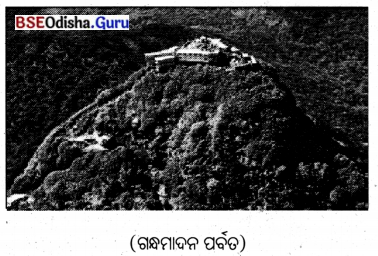
ପୁଣ୍ୟଭୂମି ଉତ୍କଳ ଗିରିନଦୀବନଭୂମିଭିଂ ବିମଣ୍ଡିତଃ । ଏତସ୍ୟ ଉଚ୍ଚତମପର୍ବତେଷୁ ଗନ୍ଧମାଦନଃ ଅନ୍ୟତମ । ଗନ୍ଧମାଦନ- ପର୍ବତମାଳାୟା ସମୁଚ୍ଚଶୃଙ୍ଗସ୍ୟ ଉଚ୍ଚତା ଚତୁର୍ବିଂଶଦଧ୍ୱକଦ୍ବାତ୍ରିଂଶତ୍ତ (୩୨୩୪) ଫୁଟପରିମିତା ଭବତି। ଏଷ ବଲାଙ୍ଗିରବରଗଡ଼- ମଣ୍ଡଳ ପ୍ରାକୃତିକପ୍ରାଚୀରମ୍ ଭବତି। ଖନିଜଦ୍ରବ୍ୟନିମିତ୍ତ ଗନ୍ଧମାଦନଃ ବିଶ୍ୱପ୍ରସିଦ୍ଧ । ଏତଃ ବଲାଙ୍ଗିରତଃ ସପ୍ତବିଂଶତି କ୍ରୋଶଦୂରେ ଅବସ୍ଥିତଃ । ଗନ୍ଧମାଦନଃ ଘନଶ୍ୟାମବନରାଜିଭି ପରିବେଷ୍ଟିତଃ । ଅତଃ ପର୍ଯ୍ୟଟକାନାଂ ମନଃ ହରତି । ଅତ୍ର ନାନାବିଧା ପଶୁପକ୍ଷିଣ ନିବସନ୍ତି । ଅନେକ ଦୁର୍ଲଭା ଆୟୁର୍ବେଦବୃକ୍ଷଲତା ସନ୍ତୋ । ଅତଃ ଗନ୍ଧମାଦନଂ ନିକଷା ଏକ ଆୟୁର୍ବେଦମହାବିଦ୍ୟାଳୟଃ ସ୍ଥାପିତଃ । ସ୍ପେନସାଙ୍ଗ ଗନ୍ଧମାଦନଂ ପରିମଳଗିରଃ ଇତି ଲିଖ୍ବାନ୍ ।
ଶବ୍ଦାର୍ଥ
ବିମଣ୍ଡିତଃ – ଅଳଂକୃତଃ, ଏତସ୍ୟ – ଏହାର, ଇତି – ବୋଲି, ଅତଃ – ଏଣୁ, ହରତି – ହରଣକରେ, ଅତ୍ର – ଏଠାରେ, ନିବସନ୍ତି – ବାସ କରନ୍ତି, ଲିଖ୍ତବାନ୍ – ଲେଖୁଥିଲେ ।
ଅନୁବାଦ
ପୁଣ୍ୟଭୂମି ଉତ୍କଳ ଗିରିନଦୀ ବନଭୂମିଦ୍ଵାରା ବିମଣ୍ଡିତ । ଏହାର ଉଚ୍ଚତମ ଶିଖର ମାନଙ୍କ ମଧ୍ୟରେ ଗନ୍ଧ ମାଦନ ଅନ୍ୟତମ । ଗନ୍ଧମାଦନପର୍ବତମାଳାର ସମୁଚ୍ଚଶିଖରର ଉଚ୍ଚତା ୩୨୩୪ ଫୁଟ । ଏହା ବଲାଙ୍ଗିର ବରଗଡ଼ ଜିଲ୍ଲାର ପ୍ରାକୃତିକ ପ୍ରାଚୀର ଅଟେ । ଖଣିଜଦ୍ରବ୍ୟ ନିମନ୍ତେ ଗନ୍ଧମାଦନ ବିଶ୍ବ ପ୍ରସିଦ୍ଧ । ଏହା ବଲାଙ୍ଗିରଠାରୁ ୨୭ କୋଶ ଦୂରରେ ଅବସ୍ଥିତ ଗନ୍ଧମାଦନ ଗହଳ ଶ୍ୟାମଳ ବନରାଜି ଦ୍ଵାରା ପରିବେଷ୍ଟିତ । ଏଣୁ ପର୍ଯ୍ୟଟକମାନଙ୍କ ମନ ହରଣକରେ । ଏଠାରେ ନାନା ପ୍ରକାର ପଶୁପକ୍ଷୀ ବାସକରନ୍ତି । ଅନେକ ଦୁର୍ଲଭ ଆୟୁର୍ବେଦବୃକ୍ଷଲତା ରହିଛି । ଏଣୁ ଗନ୍ଧମାଦନ ନିକଟରେ ଗୋଟିଏ ଆୟୁର୍ବେଦ ମହାବିଦ୍ୟାଳୟ ସ୍ଥାପିତ ହୋଇଛି । ସ୍ପେନସାଂ ଗନ୍ଧମାଦନକୁ ପରିମଳଗିରି ବୋଲି ଉଲ୍ଲେଖ କରିଛନ୍ତି ।
द्वितीय अनुच्छेद: (ଦ୍ଵିତୀୟ ଅନୁଚ୍ଛେଦଃ)
गन्धमादनस्य उत्तरपार्श्वे नृसिंहनाथमन्दिरम् अवस्थितम् । एतत् कोणार्कमन्दिरशैल्या कारुखचितं भवति । अत्र पर्वतशिखरात् जलप्रपातः तुषारभ्रमं करोति । झराणां कलनादः अतीव चित्ताकर्षकः । नृसिंहचतुर्दश्याम् अत्र एका विशाला मेला भवति । तदा यात्रिकाः भक्ताः परिवारेण सह आगच्छन्ति । भक्त्या देवं प्रणमन्ति । तस्मै पुष्पार्घ्यं समर्पयन्ति । ततः पार्वत्यमार्गेण हरिशख्दरपीठं गच्छन्ति । मार्गम् उभयतः प्राकृतिकशोभा रमणीया भवति ।
ଗନ୍ଧମାଦନସ୍ୟ ଉତ୍ତରପାର୍ଶ୍ଵ ନୃସିଂହନାଥମନ୍ଦିରମ୍ ଅବସ୍ଥିତମ୍ । ଏତତ୍ କୋଣାର୍କ ମନ୍ଦିରଶୈଲ୍ୟା କାରୁଖଚିତଂ ଭବତି । ଅତ୍ର ପର୍ବତଶିଖରାତ୍ ଜଳପ୍ରପାତଃ ତୁଷାରଭ୍ରମଂ କରୋତି । ଝରାମାଂ କଳନାଦଃ ଅତୀବ ଚିତ୍ତାକର୍ଷକଃ । ନୃସିଂହଚତୁର୍ଦ୍ଦଶ୍ୟାମ୍ ଅତ୍ର ଏକା ବିଶାଳା ମେଳା ଭବତି। ତଦା ଯାତ୍ରିକା ଭକ୍ତା ପରିବାରେଣ ସହ ଆଗଛନ୍ତି । ଭକ୍ତା ଦେବଂ ପ୍ରଣମନ୍ତ । ତନ୍ମେ ପୁଷ୍ପାଘଂ ସମର୍ପୟନ୍ତ । ତତଃ ପାର୍ବତ୍ୟମାର୍ଗେଣ ହରିଶଙ୍କରପୀଠ ଗଛନ୍ତି । ମାର୍ଗମ୍ ଉଭୟତଃ ପ୍ରାକୃତିକଶୋଭା ରମଣୀୟା ଭବତି।
![]()
ଶବ୍ଦାର୍ଥ
ଉତ୍ତରପାର୍ଶ୍ଵ – ଉତ୍ତରପଟେ, ଏତତ୍ – ଏହା, କାରୁଖଚିତଂ – କାରୁକାର୍ଯ୍ୟପୂର୍ଣ୍ଣ, ଅତ୍ର – ଏଠାରେ, ଅତୀବ – ଅତ୍ୟନ୍ତ, ତଦା – ସେତେବେଳେ, ସହ – ସହିତ, ଭକ୍ତ – ଭକ୍ତିରେ, ସମର୍ପୟନ୍ତି – ସମର୍ପଣ କରନ୍ତି, ତତଃ – ତେଣୁ, ଉଭୟତଃ – ଦୁଇପଟେ, ରମଣୀୟା – ସୁନ୍ଦର ।
ଅନୁବାଦ
ଗନ୍ଧମାଦନର ଉତ୍ତରପଟେ ନୃସିଂହନାଥମନ୍ଦିର ଅବସ୍ଥିତ । ଏହା କୋଣାର୍କଶୈଳୀରେ କାରୁକାର୍ଯ୍ୟ ପୂର୍ଣ୍ଣ ଅଟେ । ଏଠାରେ ପର୍ବତଶିଖରରୁ ପ୍ରବାହିତ ଜଳପ୍ରପାତ ତୁଷାରଭ୍ରମ ସୃଷ୍ଟିକରେ। ଝରଣାଗୁଡ଼ିକର କଳକଳ ନାଦ ଅତ୍ୟନ୍ତ ଚିତ୍ତାକର୍ଷକ । ନୃସିଂହ ଚତୁର୍ଦ୍ଦଶୀରେ ଏଠାରେ ଗୋଟିଏ ବିଶାଳ ମେଳା ହୁଏ । ସେତେବେଳେ ଯାତ୍ରୀମାନେ ଭକ୍ତମାନେ ପରିବାର ସହିତ ଆସନ୍ତି । ଭକ୍ତିରେ ଦିଅଁଙ୍କୁ ପ୍ରଣାମ କରନ୍ତି । ତାଙ୍କୁ ପୁଷ୍ପାର୍ଘ୍ୟ ସମର୍ପଣ କରନ୍ତି । ତାପରେ ପାର୍ବତ୍ୟମାର୍ଗରେ ହରିଶଙ୍କର ପୀଠକୁ ଯାଆନ୍ତି । ରାସ୍ତାର ଦୁଇପଟେ ପ୍ରାକୃତିକଶୋଭା ସୁନ୍ଦର ଅଟେ ।
तृतीय अनुच्छेदः (ତୃତୀୟ ଅନୁଚ୍ଛେଦଃ)
गन्धमादनस्य दक्षिणपार्श्वे हरिशंकरमन्दिरंर राजति।एतत् मन्दिरं नृपतेः वैजलदेवस्य पत्नी दुर्लभादेवी निर्मितवती। मन्दिर परितः विविधाः पुष्पपादपाः शोभां वर्द्धयन्ति । पर्यटकाः विहारयात्रार्थं हरिशंकरं प्रति आगच्छन्ति।यात्रिकाः देवदर्शनेन सह पर्वतारोहणस्य मोदं नयन्ति । निझरिषु जलक्रीडां कृत्वा पथश्रमम् अपनोदयन्ति । जलप्रपातानां दृश्यम् अतीव मनोहरं भवति । शीतकाले अत्रत्यपरिवेशः हर्षकः। अतः पर्यटकाः विलासिजनाः च हरिशंकरं ग्रीष्मनिवासरूपेण व्यवहरन्ति । एतत् स्थानं ओडिशाराज्यस्य प्रमुखं पर्यटनकेन्द्रं भवति । गन्धमादनगमनं विना न कश्चित् वास्तविकम् अनुभवं प्राप्नोति । अतः एतत् स्थानं सर्वेषाँ दर्शनीयम् ।
ଗନ୍ଧମାଦନସ୍ୟ ଦକ୍ଷିଣପାର୍ଶ୍ବ ହରିଶଙ୍କରମନ୍ଦିରଂ ରାଜତି । ଏତତ୍ ମନ୍ଦିରଂ ନୃପତଃ ବୈଜଳଦେବସ୍ୟ ପତ୍ନୀ ଦୁର୍ଲଭାଦେବୀ ନିର୍ମିତବତୀ । ମନ୍ଦିରଂ ପରିତଃ ବିବିଧା ପୁଷ୍ପପାଦପା ଶୋଭାଂ ବର୍ଷୟନ୍ତ । ପର୍ଯ୍ୟଟକା ବିହାରଯାତ୍ରାର୍ଥୀ ହରିଶଙ୍କରଂ ପ୍ରତି ଆଗଛନ୍ତି । ଯାତ୍ରିକାଂ ଦେବଦର୍ଶନେନ ସହ ପର୍ବତାରୋହଣସ୍ୟ ମୋଦଂ ନୟନ୍ତି । ନିର୍ଝରେଷୁ ଜଳକ୍ରୀଡ଼ା କୃତ୍ୱା ପଥଶ୍ରମମ୍ ଅପନୋଦୟନ୍ତ । ଜଳପ୍ରପାତାନାଂ ଦୃଶ୍ୟମ୍ ଅତୀବ ମନୋହରଂ ଭବତି । ଶୀତକାଳେ ଅତ୍ରତ୍ୟପରିବେଶଃ ହର୍ଷକଃ । ଅତଃ ପର୍ଯ୍ୟଟକା ବିଳା ସିଜନାଃ ଚ ହରିଶଙ୍କରଂ ଗ୍ରୀଷ୍ମ ନିବାସରୂପେଣ ବ୍ୟବହରନ୍ତି । ଏତତ୍ ସ୍ଥାନଂ ଓଡ଼ିଶାରାଜ୍ୟସ୍ୟ ପ୍ରମୁଖ ପର୍ଯ୍ୟଟନକେନ୍ଦ୍ର ଭବତି । ଗନ୍ଧମାଦନଗମନଂ ବିନା ନ କଶ୍ଚିତ୍ ବାସ୍ତବିକମନୁଭବଂ ପ୍ରାଷ୍ଟୋତି । ଅତଃ ଏତତ୍ ସ୍ଥାନଂ ସର୍ବେଷା ଦର୍ଶନୀୟମ୍ ।
ଶବ୍ଦାର୍ଥ
ନୃପତଃ ବୈଜଳଦେବସ୍ୟ – ରାଜା ବୈଜଳଦେବଙ୍କର, ନିର୍ମିତବତୀ – ନିର୍ମାଣ କରିଥିଲେ, ପରିତଃ – ଚାରିପଟେ, ବର୍ଷୟନ୍ତ – ବୃଦ୍ଧିକରନ୍ତି, ପ୍ରତି — ଆଡ଼କୁ, ଯାତ୍ରିକା – ଯାତ୍ରୀମାନେ, ମୋଦମ୍ – ଆନନ୍ଦ, କୃତ୍ୱା – କରି, ଅପନୋଦୟନ୍ତି – ମେଣ୍ଟାନ୍ତି, ମନୋହରଂ – ସୁନ୍ଦର, ହର୍ଷକଃ – ଆନନ୍ଦପ୍ରଦ, ଅତଃ – ଏଣୁ, ବ୍ୟବହରନ୍ତି ବ୍ୟବହାର କରନ୍ତି, ବିନା – ବ୍ୟତୀତ, କଶ୍ଚିତ୍ – କେହିହେଲେ, ପ୍ରାଷ୍ଟୋତି – ପାଏ ।
ଅନୁବାଦ
ଗନ୍ଧମାଦନର ଦକ୍ଷିଣପଟେ ହରିଶଙ୍କର ଶୋଭାପାଉଛି । ଏହି ମନ୍ଦିର ରାଜା ବୈଜଳଦେବଙ୍କର ପତ୍ନୀ ଦୁର୍ଲଭାଦେବୀ ନିର୍ମାଣ କରିଥିଲେ । ମନ୍ଦିର ଚାରିପଟେ ବିବିଧ ପ୍ରକାର ଫୁଲଗଛ ଶୋଭାବର୍ଦ୍ଧନ କରନ୍ତି । ପର୍ଯ୍ୟଟକମାନେ ଭ୍ରମଣ କରିବାକୁ ହରିଶଙ୍କରକୁ ଆସନ୍ତି । ଯାତ୍ରୀମାନେ ଦେବଦର୍ଶନ ସହିତ ପର୍ବତାରୋହଣର ଆନନ୍ଦ ନିଅନ୍ତି । ଝରଣାମାନଙ୍କରେ ଜଳକ୍ରୀଡ଼ା କରି ପଥଶ୍ରମ ମେଣ୍ଟାନ୍ତ । ଜଳପ୍ରପାତଗୁଡ଼ିକର ଦୃଶ୍ୟ ଅତ୍ୟନ୍ତ ମନୋହର ଅଟେ । ଶୀତଦିନେ ଏଠାରେ ପରିବେଶ ଆନନ୍ଦଦାୟକ, ଏଣୁ ଯାତ୍ରୀଗଣ ଓ ବିଳାସୀଲୋକେ ହରିଶଙ୍କରକୁ ଗ୍ରୀଷ୍ମନିବାସ ଭାବେ ବ୍ୟବହାର କରନ୍ତି । ଏହି ସ୍ଥାନ ଓଡ଼ିଶାରାଜ୍ୟର ପ୍ରମୁଖ ପର୍ଯ୍ୟଟନ କେନ୍ଦ୍ର ଅଟେ । ଗନ୍ଧମାଦନ ବିନା କେହି କେବେହେଲେ ବାସ୍ତବିକ ଅନୁଭବ ପାଇପାରେ ନାହିଁ । ଏଣୁ ଏହି ସ୍ଥାନ ସମସ୍ତେ ଦେଖୁବା ଉଚିତ।
![]()
विमण्डित:, गन्धमादन:, कलनाद:, यात्रिका:, मोदं, व्यवहरन्ति, निईरिषु, चित्ताकर्षक:।
ବିମଣ୍ଡିତଃ, ଗନ୍ଧମାଦନଃ, କଳନାଦଃ, ଯାତ୍ରିକା, ମୋଦଃ, ବ୍ୟବହରନ୍ତି, ନିର୍ଝରିଷ୍ଣୁ, ଚିତ୍ତାକର୍ଷକଃ ।
कर्तृपदानि :
उत्कल:, ग्न्धमादन:, ह्वेनसाङ़: ,मेला, यात्रिका:।
ଉତ୍କଳ, ଗନ୍ଧମାଦନଃ, ସ୍ପେନସାଙ୍ଗ, ମେଳା, ଯାତ୍ରିକା ।
क्रियापदानि :
हरति, निवसन्ति, सन्ति, करोति, समर्पयन्ति, राजति, प्राप्नोति ।
ହରତି, ନିବସନ୍ତ, ସତ୍ତି, କରୋତି, ସମର୍ପୟନ୍ତ, ରାଜତି, ପ୍ରାଷ୍ଟୋତି |
शब्दार्थ:

